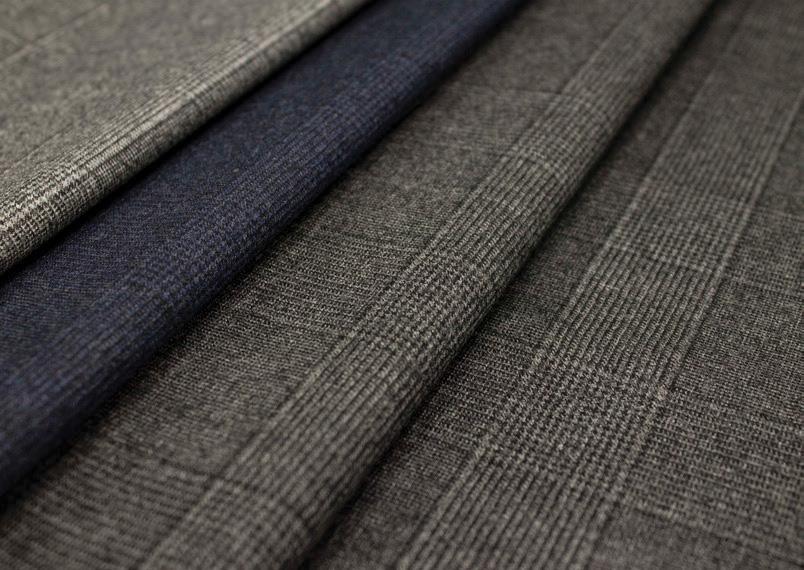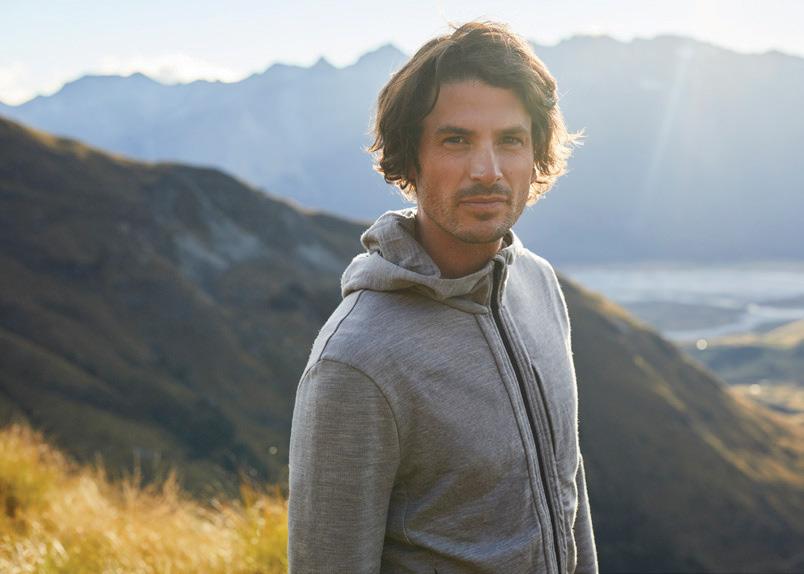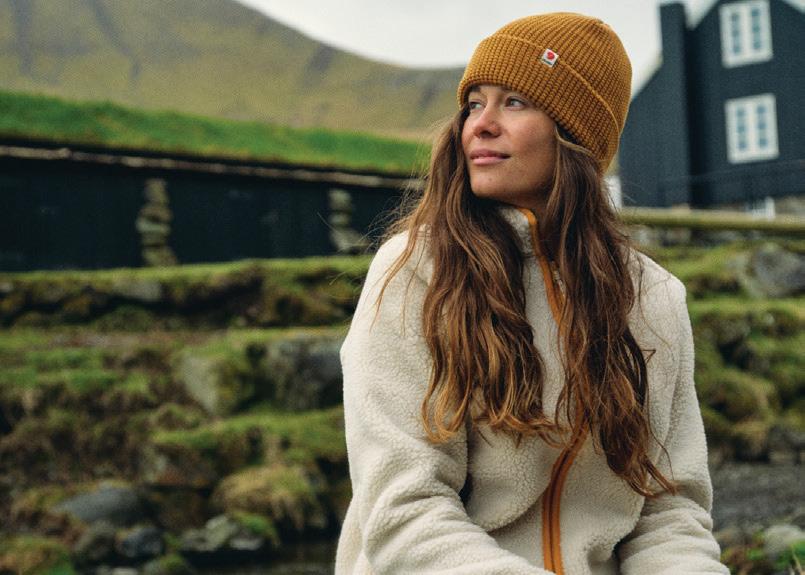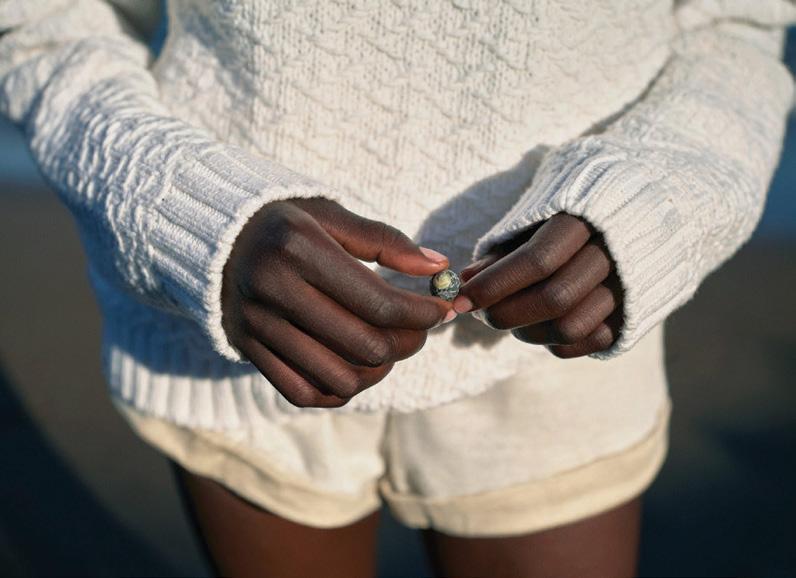 From the NZ Stud Merino Breeders Society
From the NZ Stud Merino Breeders Society








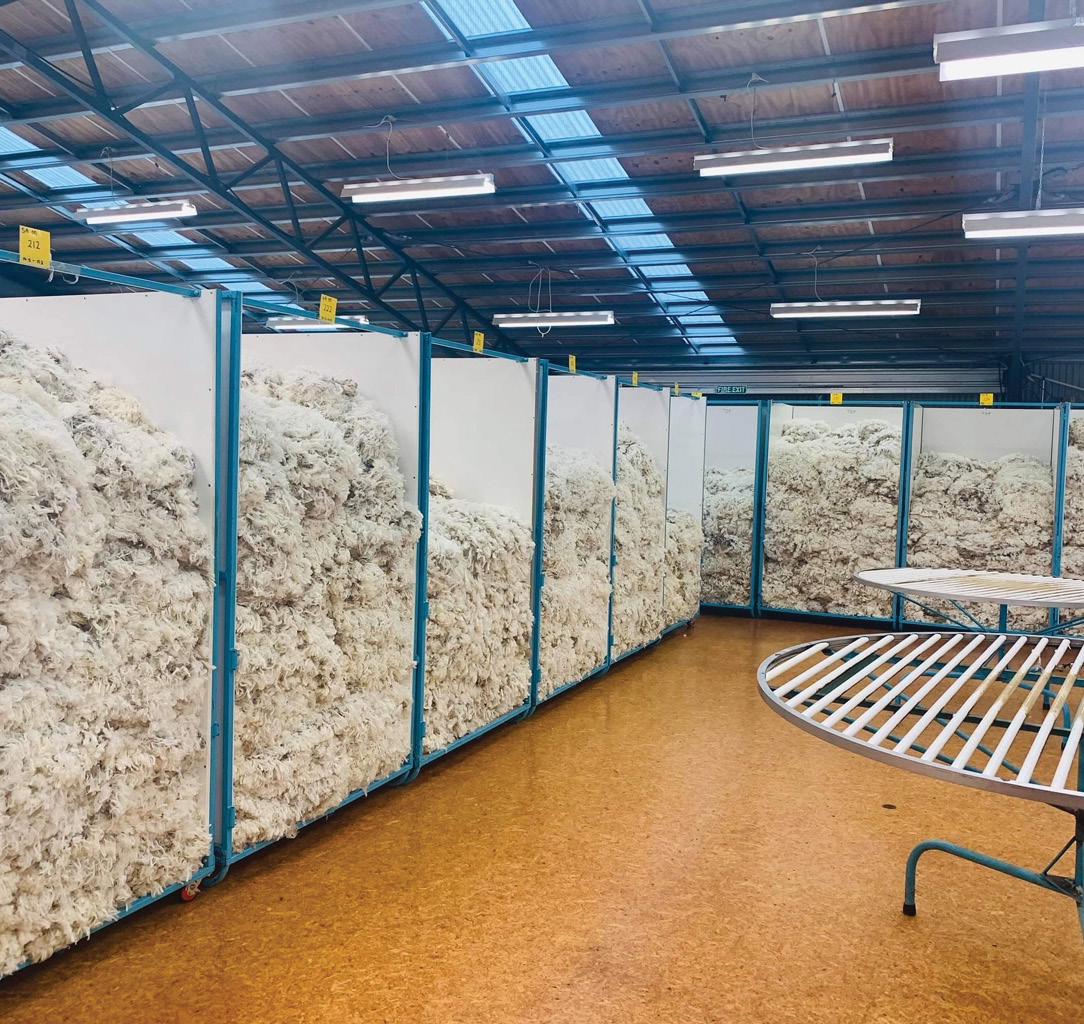









 From the NZ Stud Merino Breeders Society
From the NZ Stud Merino Breeders Society

















First, thanks to Ron Small for his time as president of the New Zealand Stud Merino Breeders Society.
Ron is an extremely passionate sheep breeder who has given up much of his time for the benefit of the industry. He has a wealth of knowledge and it’s great to have him remain on the committee.

If it wasn’t for the tsunami of regulation coming at us alongside the increasing costs the farming industry faces, the fine wool sector would be in relatively good health.
Market confidence has seen growers rewarded with long-term contracts at historically good levels coupled with exceptional lamb price returns, which are close to an all-time high.
The positivity has also been reflected in Australia with many studs holding their on-property ram sales over the past six weeks.
Confidence over there has seen
many studs averaging more than $4000 per ram, up to $5500.
While we don’t expect to see these sorts of averages in NZ, it does give breeders the confidence to invest in breeding programmes and continually drive the performance of the breed.
MerinoSelect breeding values show us that the performance of NZ-bred rams at a minimum, matches our Australian counterparts.
With the Covid lockdowns hopefully behind us now, it’ll be good to get around to the two-tooth competitions and local shows in the coming months.
The Stud Merino Breeders Society also plans to run a series of workshops in early 2023. These will focus on phenotype, correct use of ASBVs and maintaining wool quality.

We hope to see lots of farmers and stud breeders at these workshops. There will be more information in the coming weeks.
The Merino Review 2022 is produced by Country-Wide on behalf of The NZ Stud Merino Breeders Society. CountryWide is published by NZ Farm Life Media and available by subscription only.
EDITOR
Tony Leggett 027 4746 093 tony.leggett@nzfarmlife.co.nz
WRITERS
Sandra Taylor, Joanna Grigg, Lynda Gray DESIGNER Emily Rees emily.rees@nzfarmlife.co.nz
ADVERTISING SALES
Angus Kebbell 022 052 3268 angus.kebbell@nzfarmlife.co.nz
When it comes to experience, expertise and knowledge we are your trusted partner for all things wool.
PGG Wrightson is 100% committed to the New Zealand wool industry providing strong, competitive, and reliable sales platforms ranging from auction right through to long term contracts directly with international brands.
Call us today to find out how we can add value to your farming business. 0800 497 496 or visit www. pggwrightsonwool.co.nz
Subscriptions: Freephone 0800 224 782 or visit nzfarmlife.co.nz PO Box 218, Feilding 4740
Compatibility and aligned goals underpin the successful equity partnership between Phil and Tish McMurray (left) and Kate and Jack Cocks (right).
 ONFARM • Mount Nicholas
ONFARM • Mount Nicholas
Station managers Kate and Jack Cocks entered into the partnership with their stock manager Phil and wife Latisha (Tish) McMurray in July 2017. The joint business arrangement has created opportunities for both parties and greater scale and scope for the farming business.
“My view was that four of us could make a bigger and better business than two of us ever could,” Kate says in explaining the starting point for the partnership.
“Equity gives you options for the future.”
Five years on, that’s proving to be the case, there’s a quiet optimism which is a far cry from events leading to inception of the agreement.
The starting point was an out-of-the-blue brain injury that struck Jack in March 2013. An excruciating headache brought the
otherwise fit and healthy 36-year-old to a grinding halt prompting Kate to make a late night call to emergency services.
In the five hours that followed, Jack was airlifted from Mount Nicholas to Dunedin Hospital where he suffered a seizure, pulmonary oedema and a cardiac arrest, before slipping into a coma.
A brain aneurysm was diagnosed as the cause, a congenital condition that one in 10,000 are born with. Kate and Jack’s parents were given the worst possible news following an initial operation, death or, at best, confinement within a care facility. They were told the person they had known was gone for good and the chances of getting him back to his pre-aneurysm state was about 1%.
Jack’s brain was injured but sufficiently wired to bring him out of the coma after two weeks. His first conversation with Kate was to tell her that she would need to go and feed the
Mt Nicholas Stock and Plant Equity Partnership. Kate and Jack Cocks (Mt Nicholas managers). Phil and Tish McMurray (Mt Nicholas stock manager/event manager)
Extensive 36,000ha and 35,000su high country station on the north western side of Lake Wakatipu. Owned by Butson family Trust.
Rainfall: variable ranging from 736-1778mm.
Estimated average: 1270mm.
About 85% in natural cover and 6000ha fertilised and oversown developed country including 200ha of flats with 25ha of lucerne for hay and 12ha of winter brassicas.
Run in conjunction with two 200ha wintering and finishing farms for Mt Nicholas young stock near Te Anau. Merino: 11000 ewes, 12000 wethers, 7000 hoggets.
Horned Hereford: 2300 including mixed-age breed cows, heifers, steers, and bulls.
The need for management stability amid a life-changing family crisis was the starting point for an equity partnership. By Lynda Gray. Photos by Francine Boer.
dogs. Over the next six years, he underwent 15 major surgeries and spent eight months in hospital relearning to both walk and talk.
Kate, with family support, pressed on for the first 18 months juggling the farm, two preschoolers Jess and Tom, and frequent medical appointments for her husband. It was a difficult, emotional and stressful time made more so by the unknowns of the future.
“We didn’t know a lot about Jack’s prognosis and where he would end up but could see he couldn’t go back to a full-time role on the farm… Mum and Dad were making plans to move away; we had a farm to run and two preschoolers. We needed to do something.”
That ‘something’ had to bring about continuity and stability to the management of Mount Nicholas which until then, Kate and

Jack had managed with employment of two shepherds, a cook and handyman and back-up support from her parents Robert and Linda Butson. It was a traditional, effective and simple system that the family had developed and fine tuned since taking on the station in 1977.
Kate wanted to maintain the essence of that farming system and started mulling over
“They’d been working here for 18 months so we knew they were a good fit with us, our family and the lifestyle which is really important.”Mt Nicholas is a traditional and extensive high country station on the north-western side of Lake Wakatipu.
the best operational structure to achieve that while on a bedside vigil with Jack in Dunedin hospital’s ICU.
An equity partnership seemed the most likely solution to Kate, who during her career as a rural banker had been involved in several of these joint business partnerships in dairy farming. From her experience, success was dependent on finding compatible partners and for her and Jack the obvious candidates were Phil and Tish.
“They’d been working here for 18 months so we knew they were a good fit with us, our family and the lifestyle which is really important.”
The McMurrays’ employment started about
a year after Jack’s brain injury and both parties saw it initially as a stop-gap measure.
“All of us were looking for change. We weren’t sure what the future held, and Phil and Tish were a bit the same, so it suited all of us for the short term,” Kate says.
It was a surprise to the McMurrays when she approached them with her longterm idea and thinking. Phil was 27 and Tish 26 and neither had given a great deal of thought about their next farming steps. However, they were quick to see the opportunity the partnership offered.
Kate called on a former work colleague John Redpath from Rural Coach NZ, to help with the due diligence. He visited for two days

to talk collectively and with each couple to discuss the potential risks and returns and get clarity around the expectations of everyone.
The couples each got independent legal advice before the agreement was drafted. It took seven months to structure and signoff the stock and plant equity partnership which started on July 1, 2017. The beauty of a stock and plant agreement is the return on investment, which is helping achieve the first goal of equity growth.
“It (return on investment) has been 18 to 24% the last five to seven years so you can make progress, especially at this scale,” Kate says.
The second goal of land ownership has also
The Merino flock contributes about 65-70% of farm income.

been partially ticked off with the buying of a 200-hectare finishing farm near Te Anau in November 2020. It’s leased out while the Cocks and McMurrays subdivide and replace stock water to improve grazing efficiency.

The farm is about two kilometres from another Mount Nicholas-owned block making it conveniently placed for the drop off of young and surplus stock from the station. Cull Merino ewes and lambs destined for Silere contracts are winter grazed on the blocks before sale.
The shareholder agreement is the black and white grounding document of the equity partnership, setting out the legal and financial framework. But the success is dependent on other unwritten considerations such as team compatibility at a social and skill set level.

At Mount Nicholas, Phil’s strength area is stock management; Tish’s catering and event
management; Kate business and banking; and Jack technical aspects.
“You don’t want a carbon copy of yourself,” Jack says.
“We all have areas of responsibility but at the same time all do a bit of everything, so it works well.”
An equity partnership typically has an unequal shareholding but it’s important that each partner has an equal say, Kate says.
“Often the minority partner is doing most of the work and has the greatest understanding of the operational side of the business, so it’s important they have equal input.”
But at the same time the majority shareholder must be comfortable that the working arrangement is achieving the end goal.
“It’s got to be profitable and grow your equity otherwise it’s a pointless exercise.”
“It (return on investment) has been 18 to 24% the last five to seven years so you can make progress, especially at this scale...”Above: Jack and Kate took on management of Mt Nicholas in 2008. Below: The 130,000kg wool clip averages 18.1 microns.
About two-thirds of the clip is sold to Italian contracts and the remainder mostly to Icebreaker.
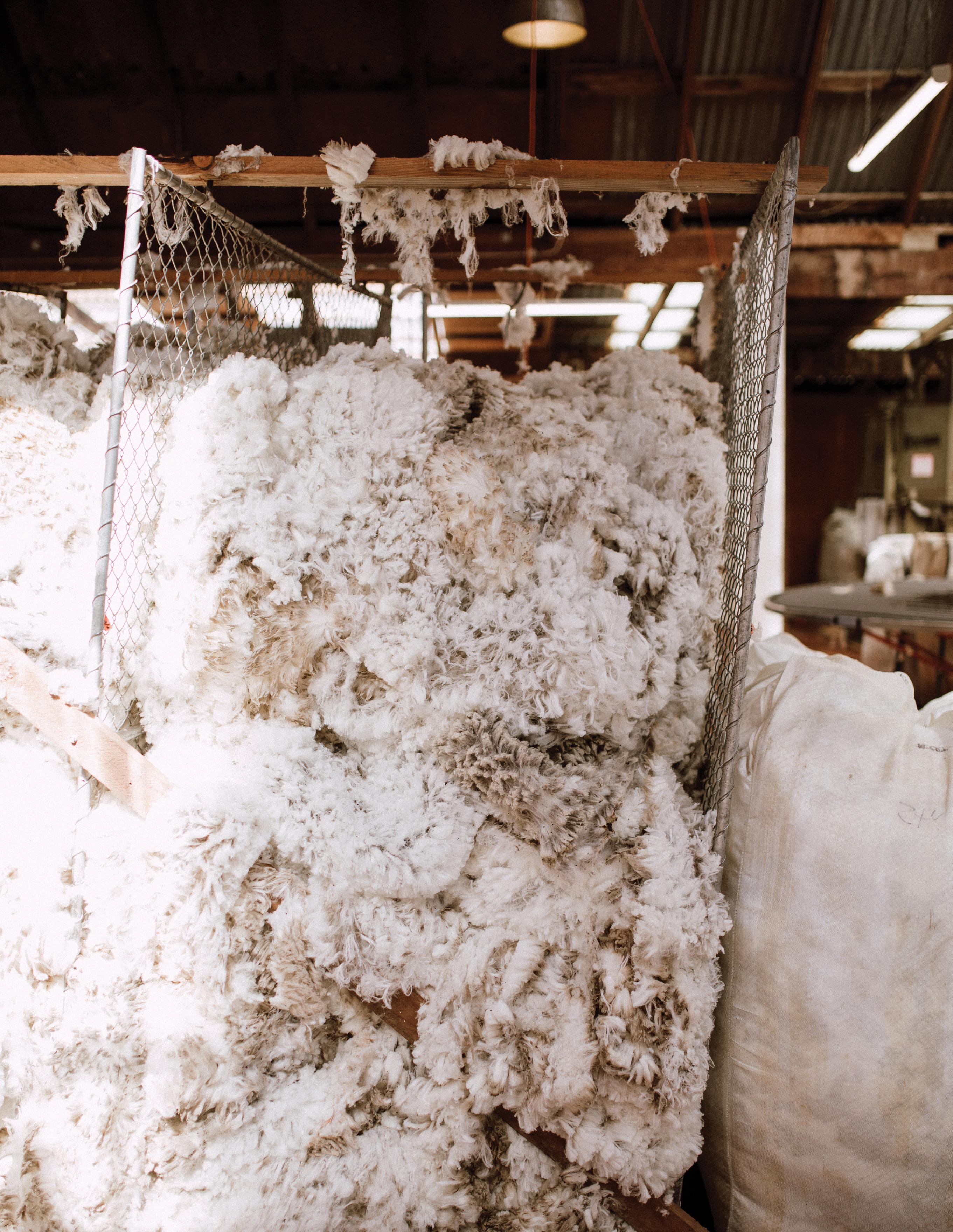
Phil and Tish, with Charlie (3) and Fletcher (4), say the equity partnership has provided a pathway to farm ownership.
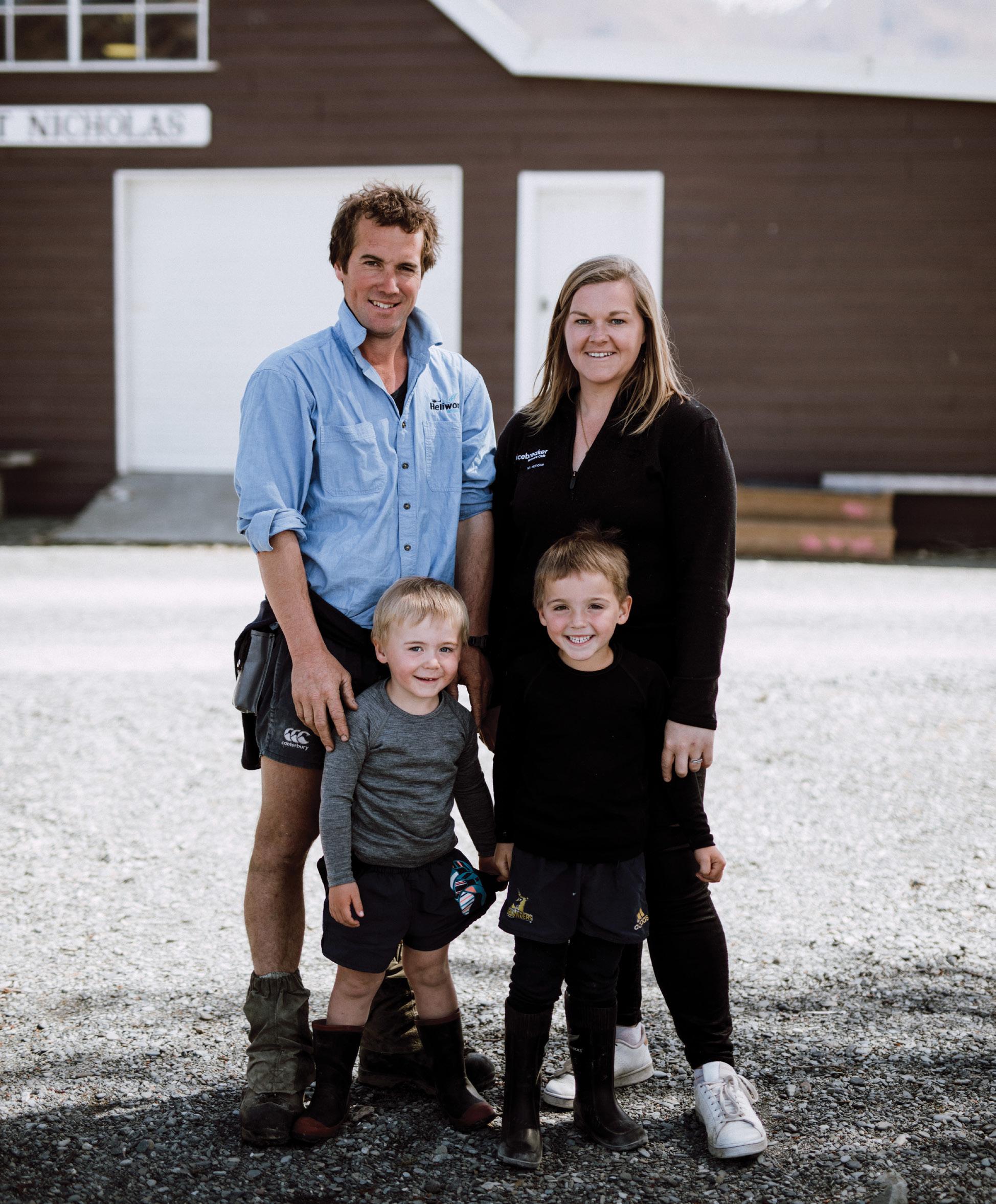
Traditional high country farming and Merino sheep were both new to Phil McMurray when he came to Mount Nicholas in 2014.
Born and raised on the family’s Taranaki sheep and beef farm he was more familiar with crossbreds. He left school at 16 for shepherding jobs in the North Island before venturing south for a change of scenery.
He worked seven years on Argyle Station at Waikaka in northern Southland. That’s where he met Tish, a local, who was working on a dairy farm.
At Mount Nicholas Phil started off as head shepherd and was promoted to stock manager within a year. Tish, a trained chef, was the station cook then took on the catering
for special events held throughout the year. The station is an easy and scenic 45-minute boat trip from Queenstown and well placed for the hosting of agri-tourism and special events which the Cocks have developed in conjunction with tourism company Southern Discoveries. Private and corporate functions are hosted in a specially renovated farm shed or marquee specially placed for stunning mountain and lake views.
The equity partnership is a great and unexpected opportunity for the McMurrays that’s created a pathway which they hope will lead to farm ownership.
Phil and Tish have two boys Fletcher (4) and Charlie (3) who love life at Mount Nicholas.
To grow equity. To buy more land. Pay off debt and when possible pay dividends to shareholders.
Run a simple, profitable operation.
A company (Mount Nicholas Ltd) owns the stock and plant with 80:20.
Shareholding (Jack and Kate: Phil and Tish).
The company pays rental on the land to Butson family Trust.
10% of plant value retained to fund plant replacement. Clearly defined ‘sunset’ clause.
Formal quarterly meetings and frequent informal discussions as required.
Ability to buy/sell shares as outlined in shareholder agreement.
Compatible partners. Aligned goals. Complementary skills which collectively add value to the farming business.
Redband
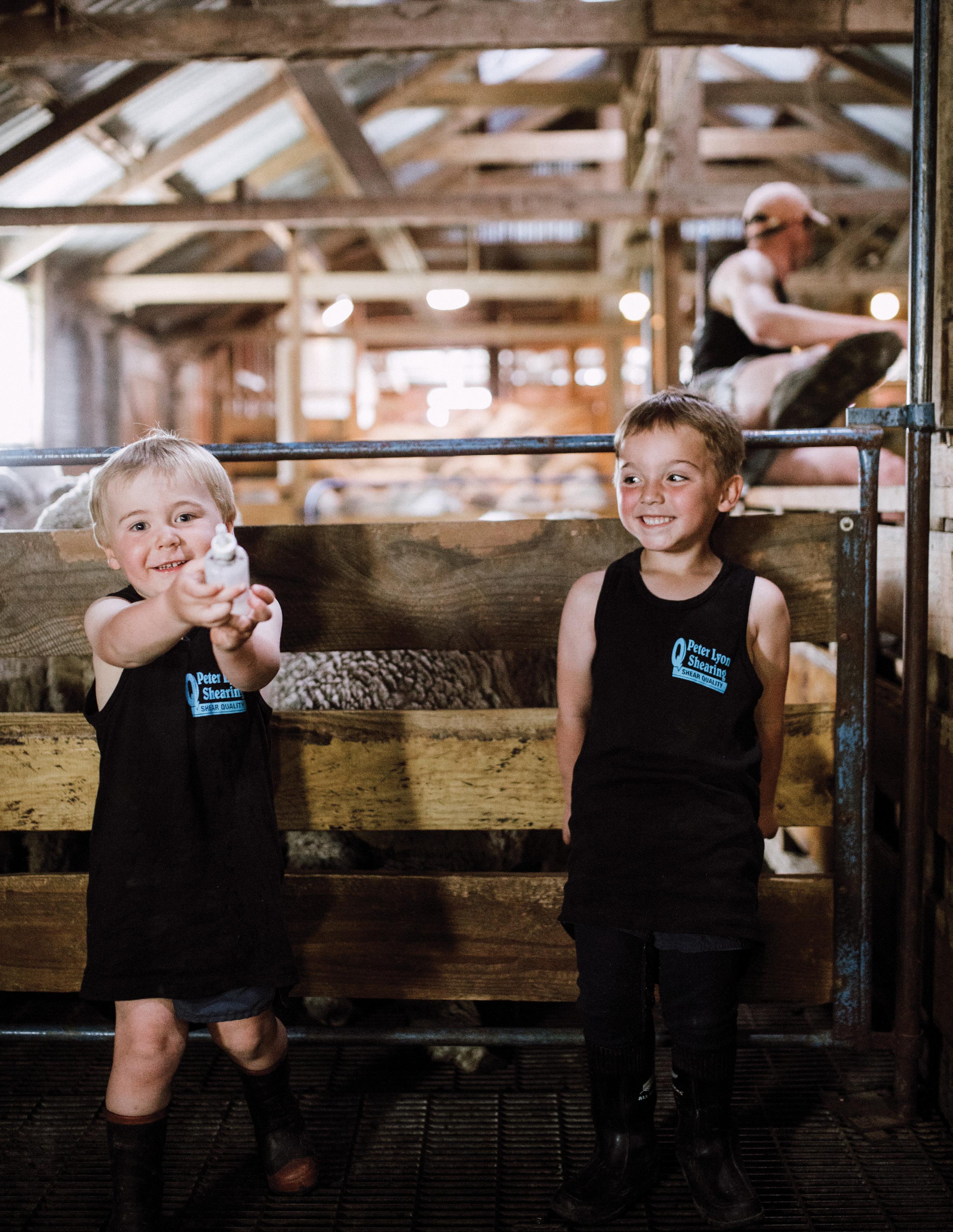 and singlet boys Charlie (left) and Fletcher (right) love helping out at shearing time.
and singlet boys Charlie (left) and Fletcher (right) love helping out at shearing time.
Mount Nicholas is a traditional Merinocentric business, but it wasn’t when Robert and Linda Butson bought it back in 1977. It was running a halfbred flock which Robert gradually replaced with Merino by introducing Matangi bloodlines.
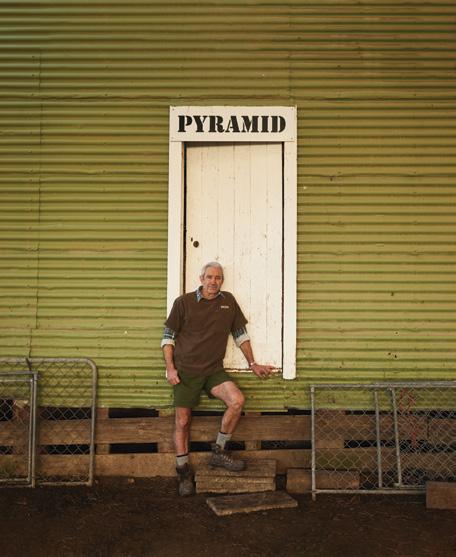

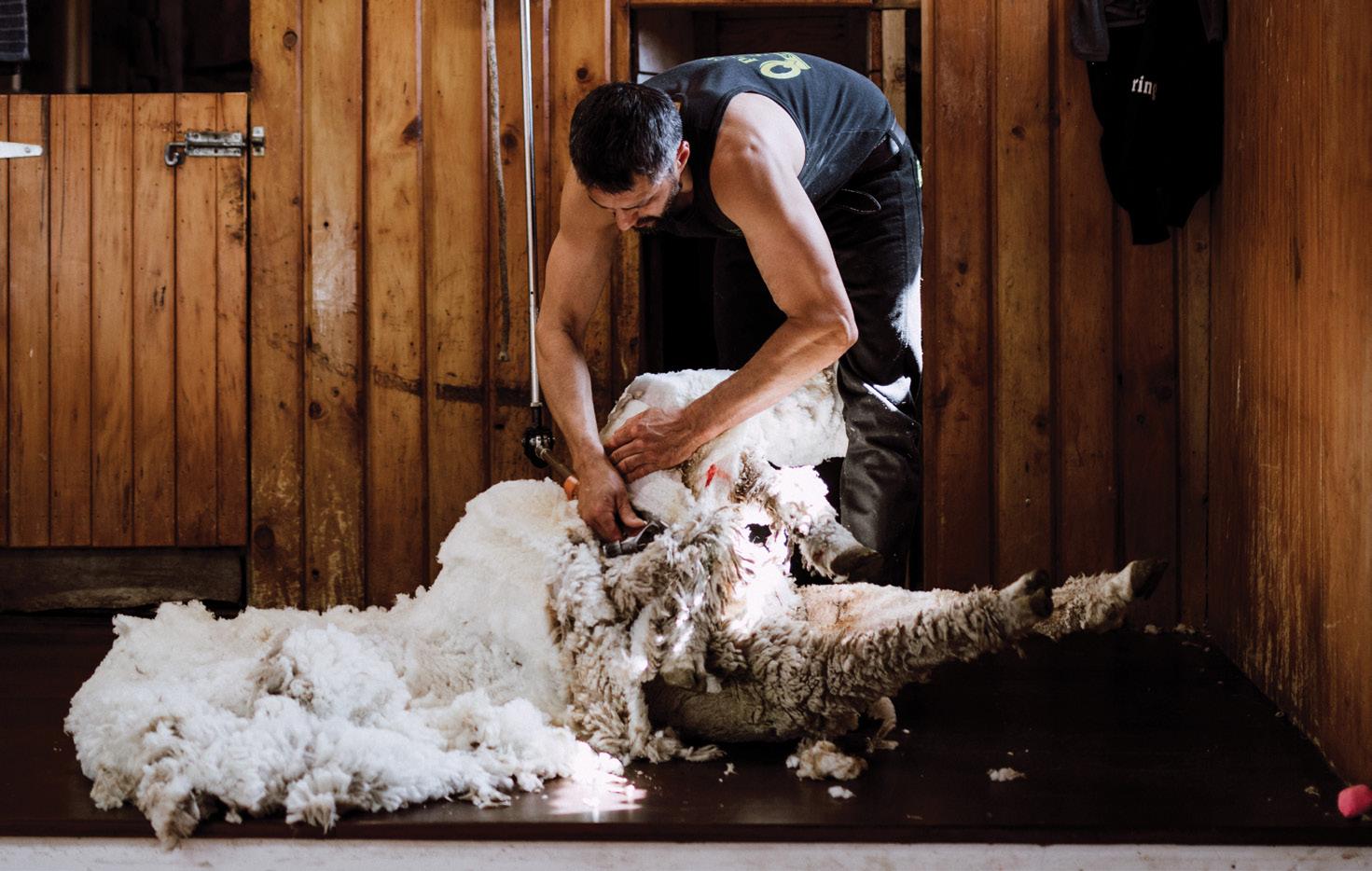
The family has stuck with those genetics which perform well in the extensive and largely undeveloped environment.
The flock contributes 65-70% of farm income primarily from the 130,000kg and 18.1 micron average wool clip. About two-thirds is sold to Italian contracts. The remaining third is sold predominantly to Icebreaker. Other Merino-related income is from lambs sold in forward store condition, generally to finishers who supply Silere Alliance contracts.
Over the last six years the wether flock has increased by 2000 to 12,000 while ewe numbers have been pegged back from 12,000 to 11,000. The wethers are easy care and profitable fine wool producers that forage the higher hill country other stock classes won't.
Cattle contribute about 25-30% of income, and agri-related tourism up to 10%.
Kate says they’re forever mindful of keeping management in tune with the unique high country environment and for that reason will not push production boundaries or greatly intensify what they’re doing.
“We’ve chosen to run a more traditional high country system. We try to utilise the whole place as best we can and keep things simple.”
Above: A picture perfect location easily accessed by boat from Queenstown make Mount Nicholas ideally placed for hosting agri-tourism and special events. Below: Shearing starts in early September and finishes in mid-October.
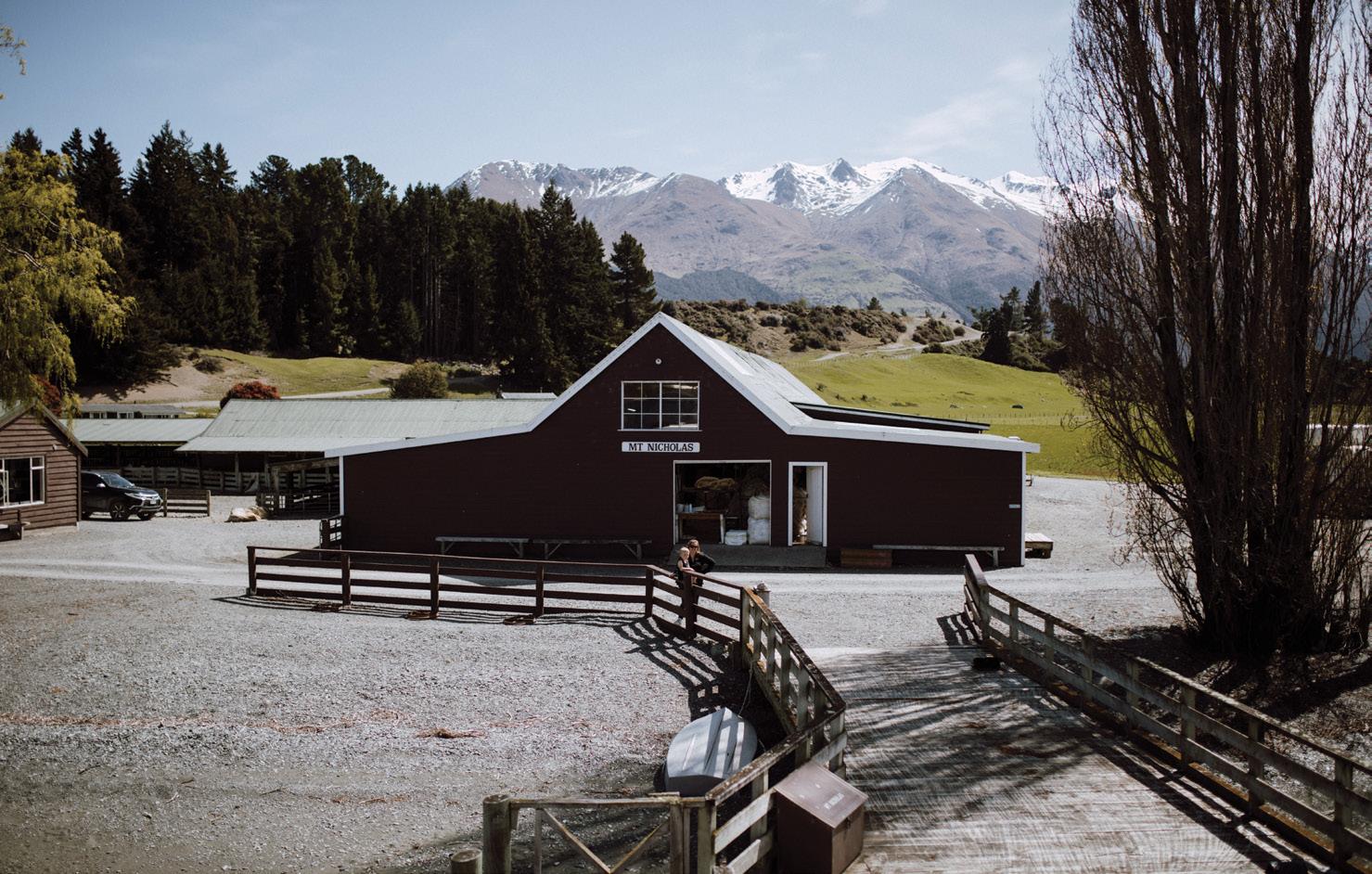
ROBERT GOULTER STILL farms sheep and cattle at Hawkesbury in Marlborough, like his great, great grandfather Cyrus Goulter.
On part of what was once the 3000-hectare Hawkesbury Run, near Renwick, he runs Corriedale ewes and a vineyard. He has farmed in his own right since he was 25 (45 years), as his father Tony died at only 51.
“I love wool but our heavy soils, on downcountry land, are more suited to a dualpurpose sheep.”
In its hey-day, from the 1870s through to

the 1960s, the Goulter Hawkesbury Merino studs had a wide influence across South Island flocks - largely thanks to Charles Goulter and his youngest of 13 children, Mary, who ran the stud through the 1950s and 1960s.
The first Goulter to own land in Marlborough was Cyrus. He was a surveyor who sailed into Nelson, aged 18, in 1842. He and brother-in-law, Joseph Ward, surveyed large areas of what became known as Marlborough.
A politician at heart, Cyrus served on
the Nelson Provincial Government when Marlborough split from Nelson governance in 1859. He served as Marlborough provincial sheriff, speaker and treasurer. In 1848, he bought 2832 ha of a sheltered valley south of Renwick, with a good mix of flats, wetlands and hills. He converted to Catholicism and married Ann Redwood.
Merinos were the only sheep available in New Zealand at the time, so he stocked the run with what he could find. The family recall Cyrus’s collection of Merinos was known as the ‘Goulter mongrels’.
Fences were few and mixing with neighbouring flocks was common.
Charles was the skilled farmer and stockbreeder in the family. He took over the running of the flocks in 1872 from his father, and went on to develop three different Merino studs – the Murray, Tasmanian and the Bulldog studs (Flock Numbers 15, 7 and 28). He also ran Lincoln and Half-bred studs, plus a highly regarded Jersey Stud.
He imported and bred thoroughbreds, English setters, Shetland ponies, fighting cocks and English game birds. Robert recalls a story that younger Goulter sisters used to dose the roosters with alcohol to make the competition more exciting.

Jack Goulter recalls a mountain totara tree on Brancott Station, called the poison tree, where they would hang poisoned mutton to poison wild dogs.
In an audio recording from 1950, Jack Goulter, Charles’s son, recalled the founding of Hawkesbury studs.
Charlie (as he was known) talked his father Cyrus into buying 25 ewes from the Rutherfords, Leslie Hills, in 1874. This flock was known as the ‘Murray’ Merinos as they were originally sourced from the John and A.B. Murray stud in South Australia. Another 30 two-tooth stud ewes were purchased and in 1878 Charles bought six ewes direct from A.B. Murray.
The Goulter stud became popular very quickly, selling £700 worth of rams (£1-£2 each). By the 1880s the stud’s reputation was growing. The trend was for heavy conditioned sheep, heavy fleeces with wrinkles (source: Marlborough Merinos Today and Yesterday, Marlborough Merino Tour Committee, 1986).
In 1881, Charles travelled to Australia to buy Murray rams. On the trip home, the £300 ram, Lustre Grand Prince, was swept overboard in a storm. The stud sent a free replacement but it was of inferior type. Robert recalls it was sterile. Charles shifted his focus to Tasmanian genetics, (first purchase was Bellevue and Scone rams, 1881).
The Goulters’ Champion ram Squire (from Tasmania) cut 17¼lb of wool (7.8kg). In 1889, the 4821 flock sheep cut an average of 8lb (4kg).
Financially, times were tough and Cyrus (who still held the purse strings) juggled bank loans and traded land. By 1889, Hawkesbury Run had 770ha of ploughed flats, in English grasses, and 40 miles (65km) of fences. It needed more development but Cyrus was reluctant.
The Goulters tried to sell part of the run to Charlie Monro (Bankhouse) but the inspection, in March, showed it to be dry and bare and he was not impressed.
Charles and his brother Redwood, went looking for another farm in the North Island. Mary Catherine Goulter, in ‘Keeper of the Sheep’, writes that this probably frightened Cyrus into investing more in the Hawkesbury property.
The hard decision was made to sell the Hawkesbury Murray stud of 2200 sheep, to Thomas Carter, of Hillersden Run, in 1891. When Hillersden was broken up in 1914, ewes went to The Shades, Flaxmere, Flaxbourne, Langley Dale, Benhopai and Birch Hill. As a result of this dispersal, Goulter genetics influenced Marlborough flocks hugely.
After Cyrus’s death and land division, Charles was left, aged 37, with 2020ha. Six men were laid off in 1893, leaving only three staff. More land was sold.
Challenges were wild dogs and sheep scab. Jack Goulter recalls a mountain totara tree on Brancott Station, called the poison tree, where they would hang poisoned mutton to poison wild dogs.
Sheep were dipped four times a year in hot lime and sulphur to cure the scab. All
Talk to your vet about incorporating a Footvax® vaccination programme into your farm’s plan. Early vaccination is the key to both its treatment and prevention.
Footvax® – the only proven 10 strain footrot vaccine www.sheepvax.co.nz/footvax



stragglers were shot by gangs of men employed for this purpose. Hawkesbury was the first property to obtain a clean certificate for scab from the government in Marlborough, he said.
As part of an assumed gentleman’s agreement with Carter, Charles was not allowed to breed Murray rams in competition. However, before Charles sold the Murray ewes to Carter, he bred a crop of lambs using finerwooled Tasmanian rams. This became Flock 7, with a focus on fine wool quality (registered 1895). Imports came from Belle Vue and Beaufort Australian studs. A Gadegast Saxony ram, via Australia, was not as bright in the wool as Goulter had expected, and he wrote to the German breeder to say so.
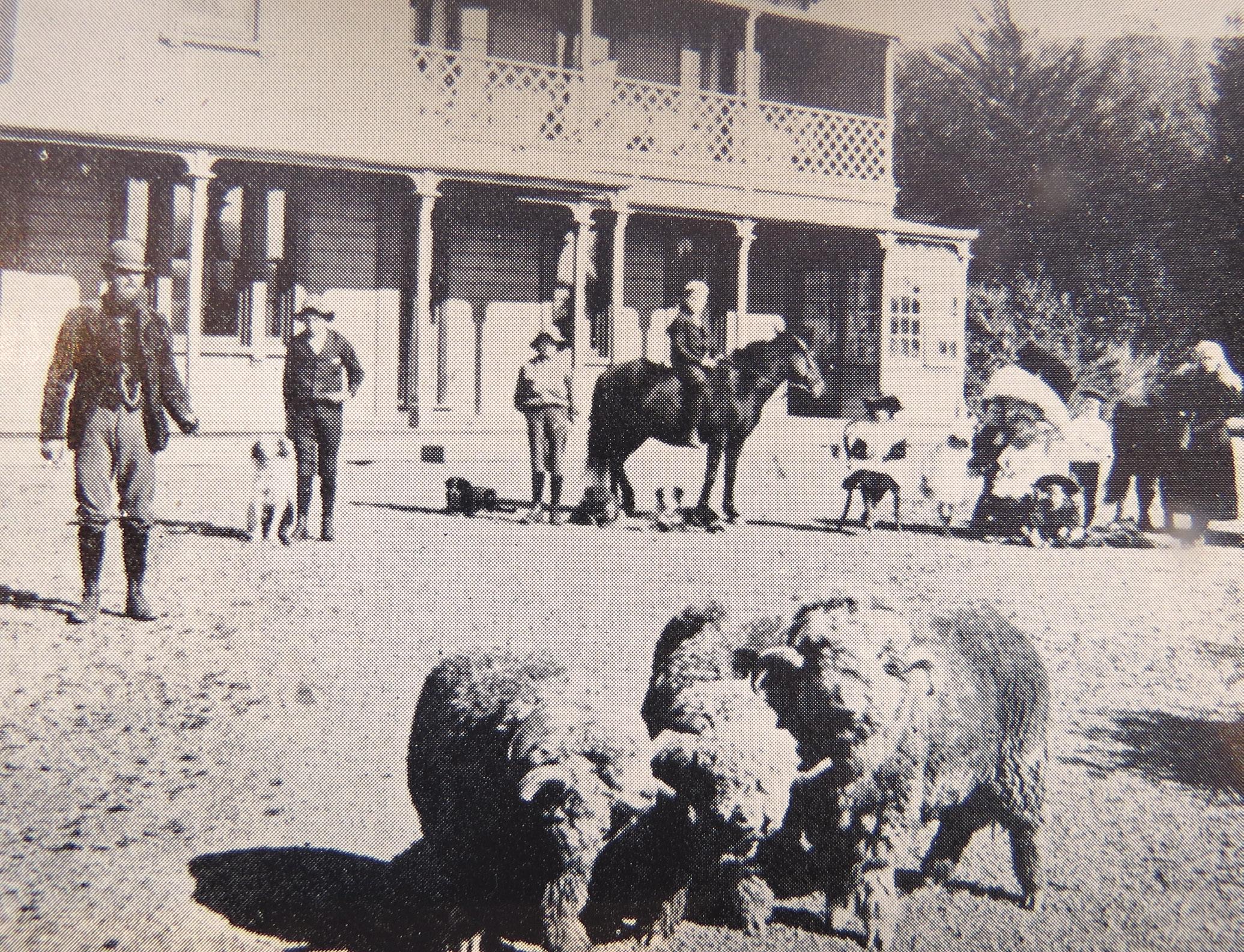
“The wool that has grown since he was shorn does not look so bright and lustrous as I should have expected from the name your sheep have got for beautiful wool, and he has some kemp on his head and also on the britch.”
Despite this hiccup, Jack Goulter recalls that this Tasmanian-blend line, was known as
being a very high-class line of rams and ewes. The Murrays were more the ‘bread and butter sheep’, he said.
As well as a fine wool stud, Charles Goulter developed a stronger wool line, quietly breeding them up at Hawkesbury from 1882. They became known as the Bulldog Merinos. This line was named for an influential stud ram - thick built, well-sprung, broad and deep through the shoulder. His 9.45kg fleece, as described by Charles, was bright, strong combing wool, well-crimped and with a dark tip, but not heavy in the tip.
“I named him Bulldog on account of his thick build, and I used him with great success for years,” he said.
This heavy-bodied Merino line was developed through experimenting over eight years; first putting three-quarter Tasmanians to quarter Murrays, and then with the reverse cross. These founding rams were Profit, Weight Cutter, Treasurer and Nugget, and
their progeny were blended together, with no outside blood.
Between 1902 (when officially registered as Flock 15) to 1930, Goulter sold 3000 stud rams from the so-called Bulldog Flock 15.
By 1904, Goulter was charging 50 guineas for the pick of them, although hard times in 1920 saw the ram average price drop to five guineas. In 1923 Goulter wool topped the Wellington sale at a record price of 30½ pence. Such were the swings in farming.
The Goulters began selling offshore (up to 100 at a time) to Hawaii, Argentina and South Africa.
In 1929 Charles visited the Mackenzie Country, with the object of finding out how Bulldogs stood the test. He visited V Le Cren at Tekapo, Mr Murray at Braemar, Mr Guinness at Glentanner. His diary recalls it was so cold and snowy, inspection was difficult.
In 1899, the Goulters bought Blairich from George McRae. It was an Awatere high country run of 4000 hectares leasehold,
2800ha freehold. Charles ran this in partnership with his cousin Bernard Ward, who sold out in 1908.
Goulter purchased 7000 sheep and banked on making a profit in year one, as wool was 6 pence a pound. He made a slim margin - £200 pounds and culled the mob by 50%, to get rid of the hairiness in the wool. Into this flock he added 100 Tasmanian-descent ewes, 100 Bulldog ewes and 100 ewes from the Murray Merino stud line, plus 30 ewes of pure Peppin blood. With this mix, he created Flock 28. Seymour Richmond, Richmond Brook, said Blairich was a tough place but not too tough for his Bulldogs.
“The quality of the sheep and beautiful bright clean wool left an impression on me, right up to these days.”
Robert Goulter said that, while the downcountry home farm was valued for its amazing ability to grow wool, it was the Blairich country to the south that Charles really loved.
“The family story is that Charlie would farm the flats but always be looking south to the hills.”
For 48 years, the Goulters ran Merinos on Blairich. In 1919, the government offered to buy it for £28,000 – well up on what Charles paid. Charles couldn’t bear to part with it and turned the offer down, in favour of keeping it in the family. He sold it to his sons Jack
and Harold. In hindsight this was a mistake as rabbits, depression in wool price and 7% interest saw £1200 pounds going out in interest costs alone. Jack sold his share to his nephew Peter and wife Clare in 1941.
Robert recalls the story that the last wool clip was handed directly to the shearers,
for shearing the sheep. It was sold in 1947 to the government for ex-servicemen. Blairich Station still carries a Merino Stud and is now farmed by Tom and Claire Small and Ron and Sue Small.
In 1924, Charles (aged 70) and his son travelled to South America, to open up a
Charles Goulter died in 1935 and his daughter, Mary Goulter re-registered the flock in 1941, using 110 three-shear ewes from her father’s estate.
She went on to sell Merino, Half-bred and Lincoln rams and win numerous competitions, including the NZ Loan Company Cup for the best 10 ewe hoggets (three times in the 1940s).
Val Goulter, of Seven Oaks, said the family knew her as Aunt Nook and she never married, instead remaining at the farm to look after her parents. During the Korean War wool boom, Robert Goulter said Mary sold wool at close to a pound for pound (£1 for 1lb) and helped clear the family loans.
NZ Merino was still highly regarded by
wool buyers. London wool buyer, Mr T.A. Beddington, speaking at a 1950 wool sale in London, said that, after buying South Island Merino wool for more than half a century, manufacturers were still very keen.
Mary died in 1968. Hawkesbury was passed 50% to her nephew Antony Goulter and 50% to her niece Nancy Monro, who were married. They had been helping on the farm. Flock 15 was finally withdrawn by Tony Goulter in 1969, with the last 16 two-tooths sold to the Rudd Family at Summerlands.
The Goulter branch of the family at Seven Oaks had a Merino stud based on Charles Goulter rams.
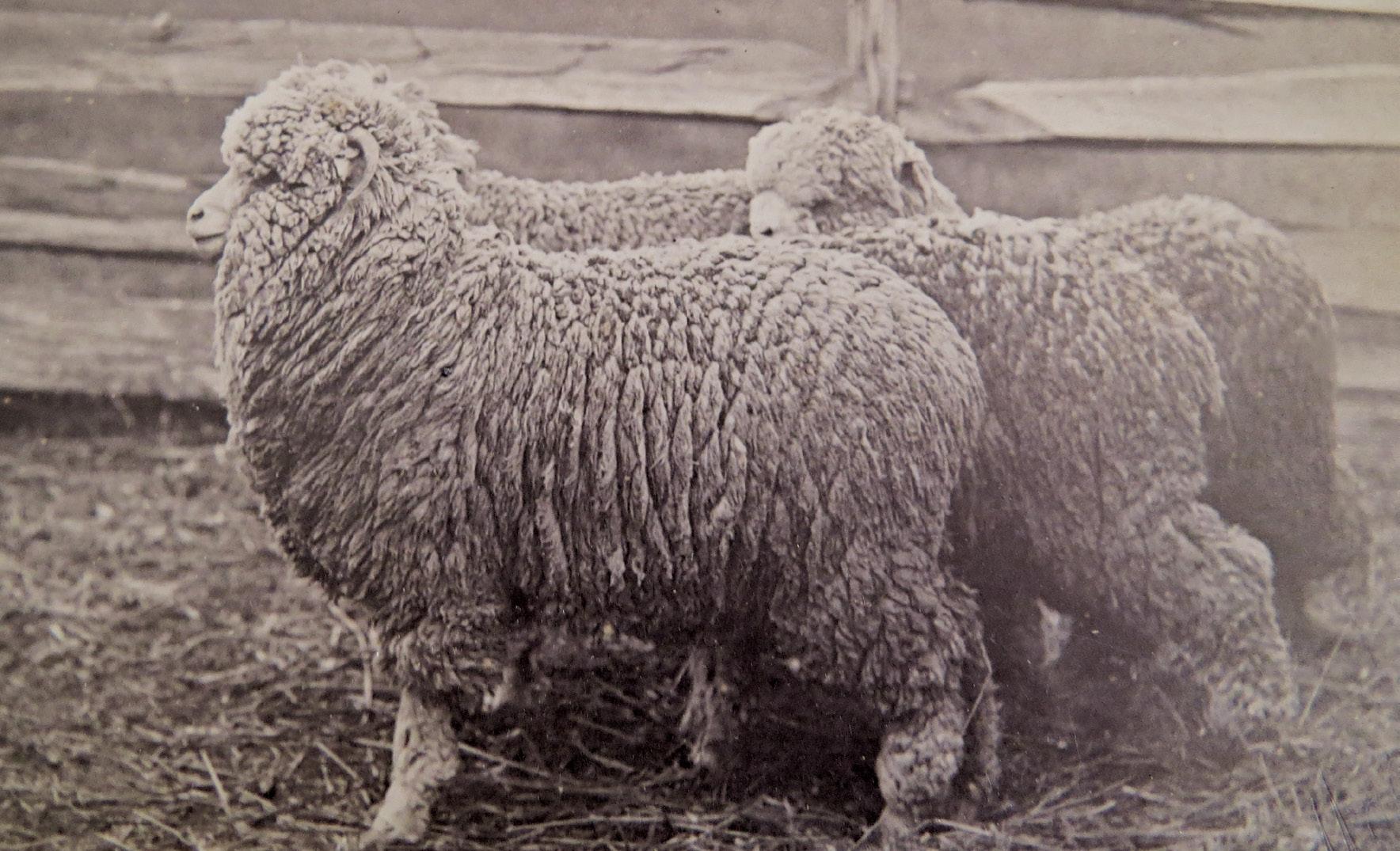
What was Hawkesbury Run is now, 170 years later, a mix of vineyards, lifestyle blocks
and some smaller sheep and beef farms. Parcels of Goulter land in the Wairau Plains changed hands several times. Descendants are many across Marlborough but it is Rob and Heather, together with Rob’s daughter Olivia, Peter Goulter and family at Becon Brae, and Val Goulter, Seven Oaks, together with Cath (nee Goulter) and Paul Baker, that farm some of the original areas.
The Goulter cob cottage is now owned by Rob’s niece Hannah Cowdrey (nee Goulter) and Zac. The cottage was built by a group of North Canterbury farmers in 1848, to provide accommodation while overnighting stock on the Canterbury Marlborough route. Robert recalls the sheep were held in the loop of the stream, which acted as a holding paddock.
market for Marlborough Merinos. Each breeder sent three rams, which were selected by Charles for quality. The market did not persist.
Charles lived for 81 years and was hugely liked by his family and respected by the community, Rob said. He classed flocks throughout Marlborough – Starborough, Ugbrooke (halfbred), Leefield, Richmond Brook, Bankhouse and Hillesden.
Seymour Richardson, Richmond Brook, said Goulter’s knowledge and study of Merino wool had a very big influence on the big Merino clips of that time.
“In those days the wools were the essence of quality and it was due only to the quality of the rams bred at Hawkesbury.”
Charles was known to turn down sales of certain rams into flocks, where he considered they were ill-suited. When asked for a simple explanation of his selection methods, Charles said first and foremost constitution, next aim for quantity of wool; when you have these both, then set about improving the quality of wool.
He believed in line breeding to fix a type. For 46 years he bred Bulldog Merino, all direct descendants of one ram.
“When Charles’ funeral procession passed the saleyards, they stopped the sale and doffed their hats,” Robert said.
Charles Goulter bought a Peppin ram in 1923, for the magnificent sum of £1000. Charles saw him at a sheep tour through Blenheim and inspected him and liked him. The sire had sold for 2100 guineas in Australia. He bought him for the fine bright wool. Commotion did not live long and his head now hangs in the Renwick Museum (note: the family are fairly sure the head is Commotion, not 100%).
Samples of Hawkesbury stud ewe wool, taken in 1890, are in the Powerhouse Museum, Sydney. This collection contains thousands of Australian and New Zealand wool samples, collected between 1804 and 2003.
Alfred Hawkesworth, honorary wool-classer to the museum wrote, in 1890, that the samples from Charles Goulter were a grand specimen of deep fine combing wool.
“It’s one that shows good breeding, with the best of manufacturing properties, and is a great favourite with the makers of fine worsted goods.”
Staple length was four inches (10cm) and was capable of standing any reasonable extra twist during spinning into warp yarns, he wrote. The fibres had a distant wave, were pliable and given a value of 12 pence per
One of the 50 or so medals awarded to Charles Goulter for sheep breeding success (this one for Champion Ram at the Marlborough A&P Show, 1886).

pound. He praised the Goulters on their judgement and great care shown in the selection and packaging of the wool.
“As an educational and instructive collection, this is one of the most perfect in the whole of this wool section. It illustrates fine, medium and strong.”
He said it shows the necessity of keeping the different lengths and qualities separate when presenting to buyers.
“The temperate and bracing conditions of Marlborough had a beneficial effect upon the wool’s condition and lustre.”
The original 1864 woolshed is intact and will be Robert’s next restoration project.
READ: The story of Charles Goulter is recorded in Keeper of the Sheep, Mary Catherine Goulter, 1955.
LISTEN: The 1950 recording of MERINO: A story of sheep is available to listen to at https://www.ngataonga.org.nz/collections/ catalogue/catalogue-item?record_id=208422

NORWEGIAN-BASED TEXTILE company, Devold, has an ambitious plan to grow their wool purchases from New Zealand.
Devold Wool Direct general manager Craig Smith, is the company’s man on the ground in the wool market.
The company is unashamedly seeking what Smith calls aggressive growth. Devold produced 1.2 million garments from its Lithuanian factory in 2019 and expects to manufacture 2.3m this year. Of these garments, 85% are entirely New Zealand wool, with the balance in Norwegian wool or other materials.
Initially buying through PGG Wrightson for seven years, Devold set up a separate buying entity in 2018. This created a vertical chain of ownership from wool buyer to garment manufacturer. PGGW still provides testing and storage.
Smith said the company has offered oneto-four-year contracts to encourage growers to commit.
“With a goal of doubling sales, we can only do that if we get the right quality wool to make that happen.”
By this he means sub-20-micron wool that is at least 80mm long in the staple, has a strength of 38 Nkt and low vegetable contaminants (maximum 1.5%). Prices range from $27/kg clean for the fine edge through to $20.50/kg clean for 20 micron wools, Smith said.
An extra carrot recently offered by Devold is a $2/kg premium, for extra length. Wool under 18 micron has to be more than 95mm to receive the bonus, while 18 to 20 micron wool has to be longer than 105mm.
“Yes, it’s long but I’m actually surprised the number of growers actually achieving this –along with the right strength.”
Smith had just received a consignment of 103 bales of 17.7 micron wool, where 85% met the premium for length. It had a good strength rating of 43 Nkt, he said.
To date 43 growers are on board, together supplying around 20% of NZ’s available Merino clip to Devold, Smith said.
Smith estimates NZ growers produce about 60,000 bales of under-20 micron wool, of which 60% could fit the Devold specifications, excluding oddments. Smith is targeting to grow from 20% market share to 40% of suitable wool.
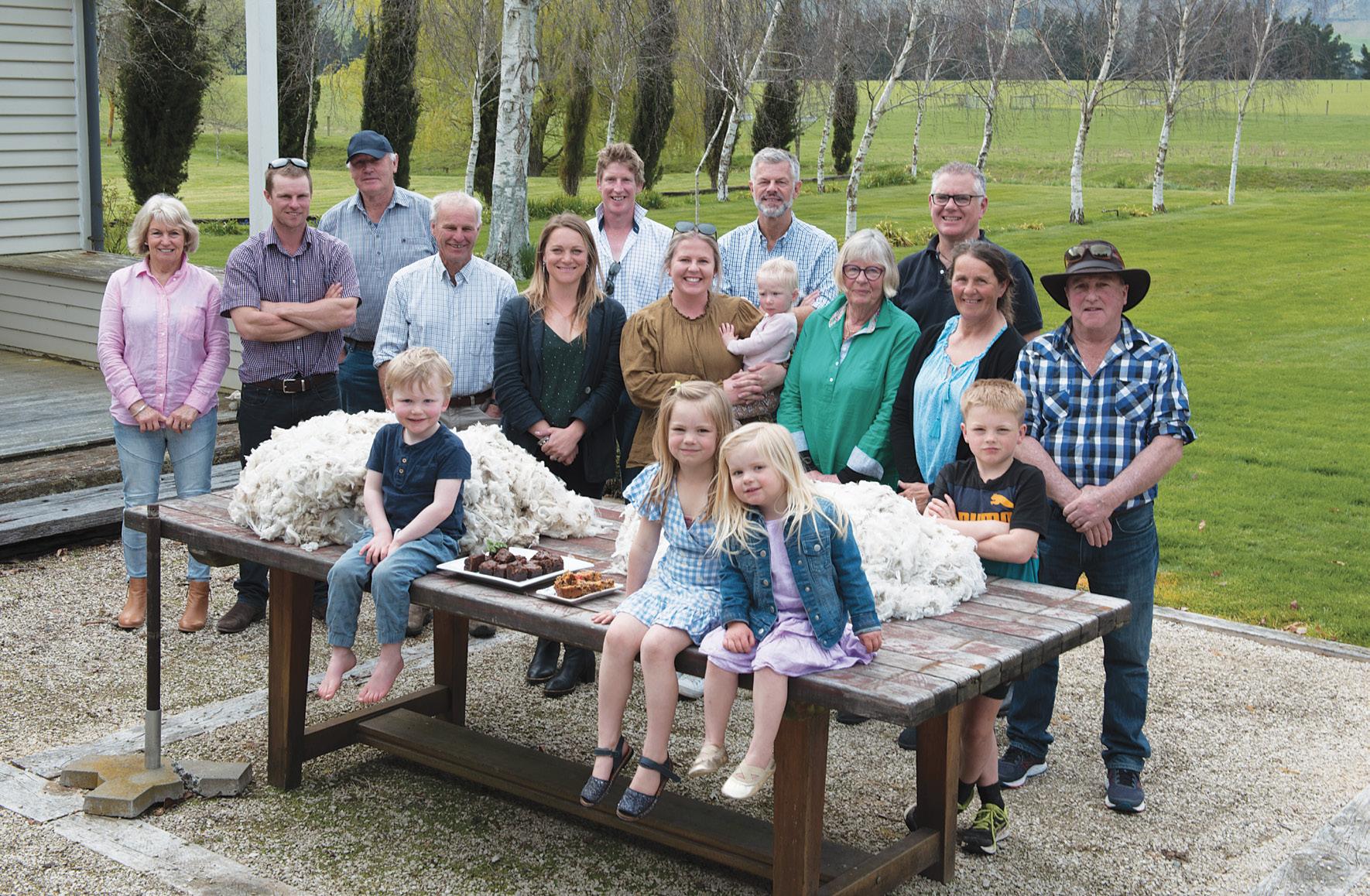
“Why not aim for the stars – people are really starting to talk about Devold.”
Not all wool will match, with shorter under-20 micron wool better-suited to the Italian market, he said.
He believes increased competition for wool
is only good for growers.
“We’ve already seen this consistency in price giving growers confidence to shift genetics, in a certain direction.”
There are lots of reasons to quit Merinos, like footrot and fly, so having good priced contracts with no upper limit of wool length, is needed to keep the industry going.
“I’m pleased to see growers building hogget numbers on properties and wether flocks coming back to the high country.”
Decreasing wool micron, length and volume, in favour of carcase weight traits and fertility, is not the track Smith thinks Merino growers should go down.
“I wonder whether extra lambing percentage and weaning weight is really worth it, when sacrificing wool volume and colour.”
Australian wool is no longer bought by Devold, due to climate variations causing rapid changes in micron, strength and style.
“We need consistency; that’s why we bundle wool lines together based on regions.”
Growers need to be NZFAP accredited. Smith said that this assurance programme is ideal and that an independent assurance scheme is better than one tied to a particular brand or broker.
“Assurance should be independent from the brand or broker.”
Behind the Devold brand is the Norwegian Flakk Group, with investments across property, tourism, and sustainable building products, including log homes.
Flakk Group chairman and chief executive Knut Flakk toured Marlborough, Canterbury and Otago in September to learn more about wool and to meet with wool growers. He said he likes buying wool from New Zealand.
“New Zealand has been a great choice – they are keen to deliver to us what we want and are prepared to adjust the breeding. It’s really positive.”
He thinks it has been easier to establish a network than perhaps in Australia.
Devold has an ambition to be the world’s leading wool brand but Flakk said the company doesn’t seek to be the biggest. The company is looking to double volumes drawn from the NZ Merino market, however.
“We don’t want to be disruptive to the market. If the market is limited, we accept that.”
Flakk has a history of turning around lagging businesses. When the family business acquired Devold in 1989 he described it as a distressed asset.
“I went to buy the buildings in Norway and ended up buying the company too, and we
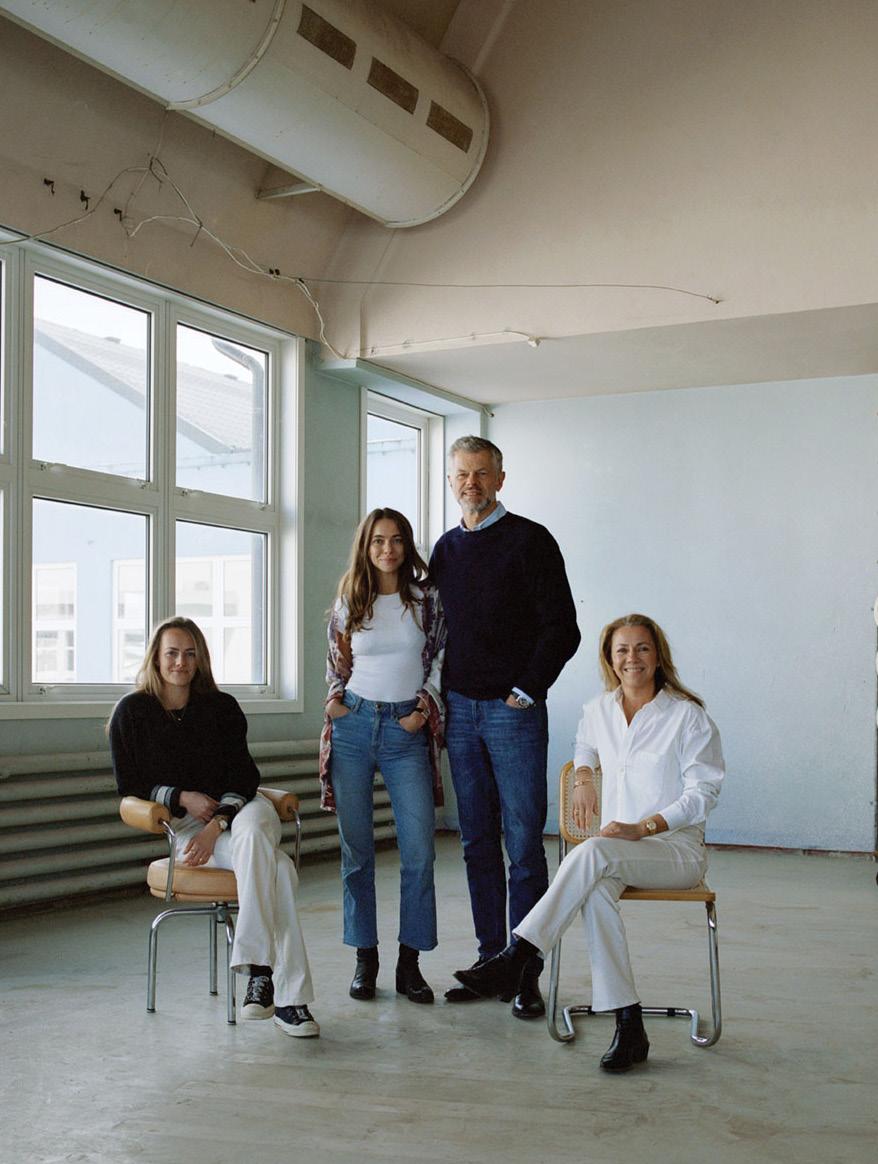
spent 10 years turning it around.”
Key to both top-line and bottom-line growth, he said, has been moving processing to Lithuania and investing in technology. It was a shame to move a company that had been in Norway since 1853, but necessary to keep production costs down, he said.
Norwegian culture is to wear layers of wool – both base and top layers. This includes wool underwear – something he remembers as a young man being not quite as smooth as he would like.
The original Devold factory site, in Langevaag, western Norway, is now a retail outlet with shops, cafés and artists’ workshops. Knut Flakk’s daughters are both involved in the Flakk business as fourth generation. Maria is a board member of Devold, and Erika is project manager at Flakk Group. About 44% of revenue in 2021 came from the textile business and close to 60% of the EBITDA from textiles. This indicates that the textile part of the group outperformed other parts of the business. Over
the Flakk Group, revenue has grown 12% since 2015. Devold plans to enter the North American market within 10 years.
Devold’s Lithuania factory general manager Tor Jonsson travelled with Flakk to NZ. The company has hosted wool growers to the factory and plans another visit for NZ growers in winter 2023.
The circular knitting machines are relatively new compared to some of the aging plant around the world - around seven years old. The factory produces a range of garments, including one with an inner layer made of 100% Merino wool, while the outer layer is 90% Aquaduct-treated Merino wool. This is wool combined with 10% polyamide to improve durability.
The Aquaduct Merino wool is specifically designed to move moisture away from the skin side of the fabric to the outer surface where it evaporates. As part of telling the ‘sheep to shop’ story in NZ, Devold has a retail store in Wanaka.
IT’S A WINNING FORMULA.
The right combination of people, skills, genetics and management was behind Lake Coleridge Station’s win in this year’s Canterbury Merino Association’s two-tooth ewe competition but more importantly, this combination has been instrumental in driving the ongoing productivity and productivity of the 6500-hectare high country station.
Owned by Christchurch businessman Bruce Miles and his wife Kay, Mid Canterbury’s Lake Coleridge Station has had a long history of running Merinos and theirs is one of the few remaining Merino flocks among neighouring Romneys.

Since taking over the station in 2001, Bruce and Kay have made a concerted effort to improve their Merino flock and over the years have enlisted the services of the late renowned sheep classer Gordon McMaster and the skills of the previous manager Brian Kirk to breed a flock that delivers in both fertility and wool.
More recently, Australian-based sheep classer Chris Bowron has helped select replacement ewe lambs and two-tooths.
Typically, 1200 ewe lambs are retained as replacements which helps keep the age structure of the flock young.
Manager Mark Rose and his wife Rebecca say they are now in a period of consolidation and they work closely with their stud breeders Will and Emily Murray from Glenmore who produce the genetics that deliver the type of ewe they want for their environment.
Mark says the Glenmore, near Tekapo, has a harsher climate than Lake Coleridge’s so they find the sheep adjust easily to a slightly more benign environment.
Left: Lake Coleridge Station manager Mark Rose with an 18.5 micron ewe fleece. He focuses on producing a well-nourished fleece and credits the strong Nor West winds for keeping fleeces dry and white. Opposite page: Merino ewes and lambs. Mark says ewe fertility is where they want to be in their environment, although they expect incremental increases in line with increases in drymatter production and genetic progress.
Today the Lake Coleridge Station ewes are clipping 5.5-6kg fleeces of 18.5 micron wool, with most of the clip going into a 10-year Icebreaker contract. The station is ZQ accredited, meaning they are farming with high standards of animal welfare and environment sustainability.
The ewes are consistently lambing 109% to the ram, which Mark feels is ideal for their environment.
Mark and Rebecca have been managing Lake Coleridge Station for eight years and also oversee neighbouring stations Acheron Bank and Mt Oakden, all together 10,000ha, which are also owned by Bruce and Kay. Collectively, the business also employs three single shepherds, two stock managers and a tractor driver.
While Acheron Bank and Lake Coleridge Station are run as one, Acheron Bank runs a Romney ewe flock, as does Mt Oaken.
On Lake Coleridge, Mark and Rebecca are continuing the work started by their predecessors as they strive to reduce fleece variations even further and breed ewes that
will continue to perform, despite the couple’s aim to reduce their reliance on drenchs.
Mark says Merinos are an ideal fit for Lake Coleridge. Compared to neighbouring properties, the farm’s lighter, more fragile, free-draining soils are suited to the Merinos’ browsing-type habits and the Nor’ West wind, which belts across the Southern Alps, keeps fleeces dry and white.
The station, which flanks Lake Coleridge, runs from 500 metres to 1000m and has 700ha of cultivable land.
This allows them to grow a range of forage crops upon which they winter all their ewes, young capital stock and finishing stock.
The ewes go to the ram on May 10, with the main ewes going to the Merino ram while the B line ewes, which are classed out as twotooths and four-tooths, go to a Romney ram for breeding sought-after Halfbred ewe lambs. All wether lambs will either be finished prime after their first winter or sold store depending on the season and markets.
Mark says he gives any A line wet dry ewes a second chance, as he feels it is unfair to
penalise a ewe that might have lost a lamb due to the extreme weather they can experience over lambing.
After mating, the ewes spend winter on brassica crops supplemented with lucerne silage. This is made with the station’s 35ha of lucerne grown primarily for making supplementary feed.
Including two-tooths, the ewes scan about 144% which Mark says is where they want to be in their environment.
“You can get too many lambs; we just don’t have the country for too many multiples.”
He expects they will continue to make incremental gains in fertility and lambing percentages as they continue to lift the fertility and productivity of their hill country pastures.

“The beauty of the Merinos managementwise is that there is room to move and the Merinos do respond to feed,” he says.
Genetics will also play an important part in increasing ewe fertility and Mark says they expect to improve in line with the Glenmore genetics.
The main shearing on Lake Coleridge
Station takes place in July and this year, ongoing wet weather meant it took five weeks to do five days’ shearing. The hoggets are shorn in September and they typically clip a 3kg, 17.9 micron fleece.
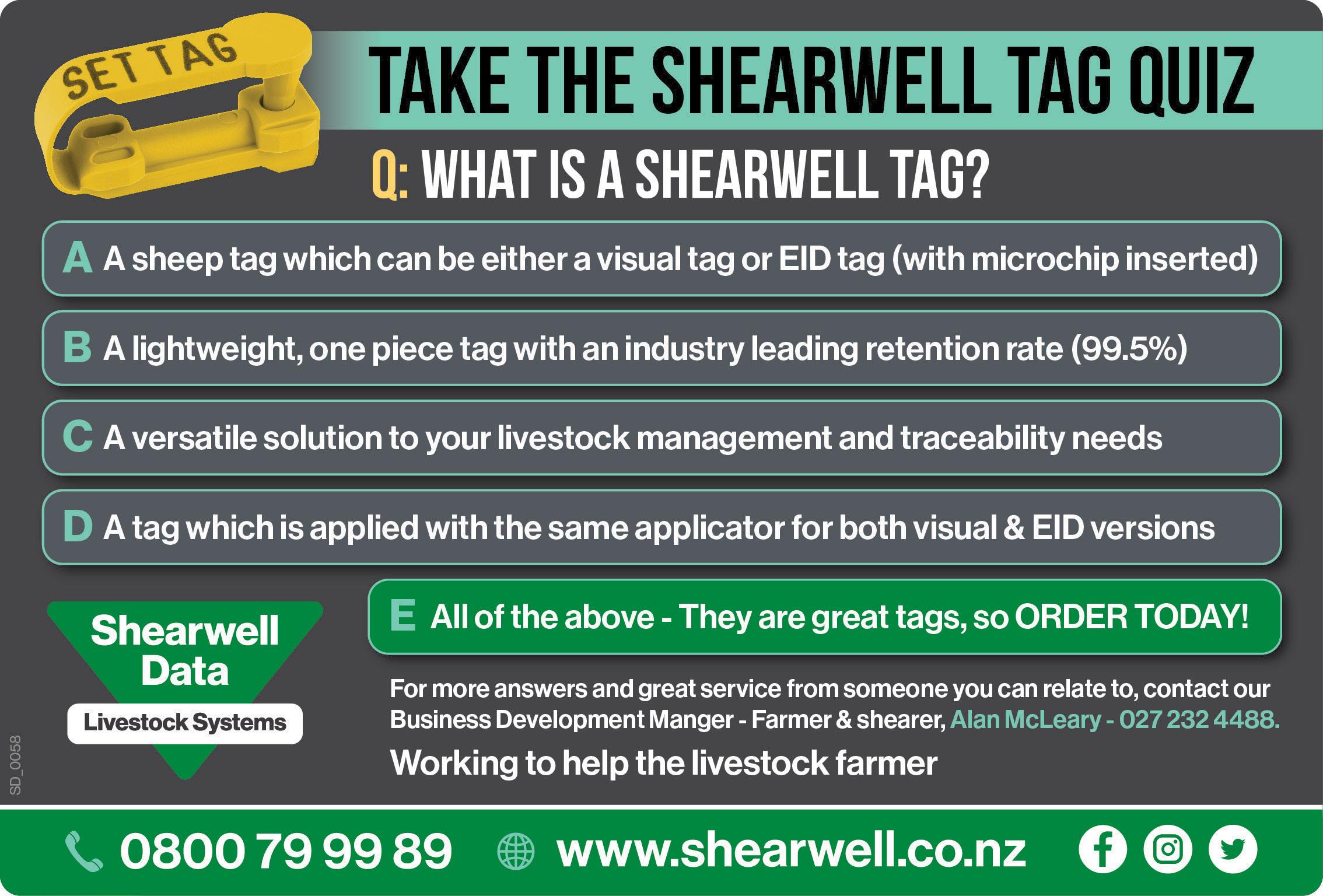
Mark says they aim to produce wellnourished fleeces with enough lanolin to help prevent dust penetrating the fleece.
This means running well-nourished sheep which they are able to do through a mixture of developed pastures and crops.
Going into lambing on October 5, the ewes are set-stocked lightly, at less than 1/ha, on hill country while multiple-bearing ewes are on easier paddock country at a low stocking rate.
Mark doesn’t foetal age at scanning as he tries to avoid having too many ewes lambing at the same time. He believes Merinos need space and they are able to give them that on their country.
Weaning has traditionally taken place in February, but Mark is moving this forward as he finds this is too late. By February the lambs are competing with the ewes to the detriment
of both. A late January weaning will allow more feed to be partitioned back into building ewe condition going into mating.
After weaning the ewes go out to their summer country, that lies adjacent to retired steep hill country, which is only ever grazed at that time of year.
They are then brought down to the paddock country for mating.
With such a short growing season, crops and high-quality pastures are critical to drive sheep and cattle performance on Lake Coleridge Station.
Along with swedes and brassicas used for wintering ewes and hoggets, ryecorn is a crop that is valued for its ability to generate a bulk of high-quality feed in their environment, while also protecting soils, particularly when used as a cover crop.
They grow about 70ha of ryecorn every year and it will be stitched into swede crops and after grazing, will be drilled with a brassica.
“The beauty of the Merinos management-wise is that there is room to move and the Merinos do respond to feed.”
“The ryecorn holds it all together so we can drill without the soil being blown away.”
“It’s just so reliable,” Mark says.
While the lucerne provides them with valuable high-quality supplementary feed, as well as forage for ewe lambs in late summer, it is challenging to manage in their environment.

Because it grows upright, the lucerne plant does leave soil exposed after cutting or grazing. This makes the paddock vulnerable to wind blow which does impact on stand longevity.
On the advice of their vet, and former agronomist, Mark and Rebecca have been establishing permanent pastures made up of a mix of ryegrass, cocksfoot, subterranean and white clover, lucerne and plantain with the idea that each species would come into its own at different times of the growing season.
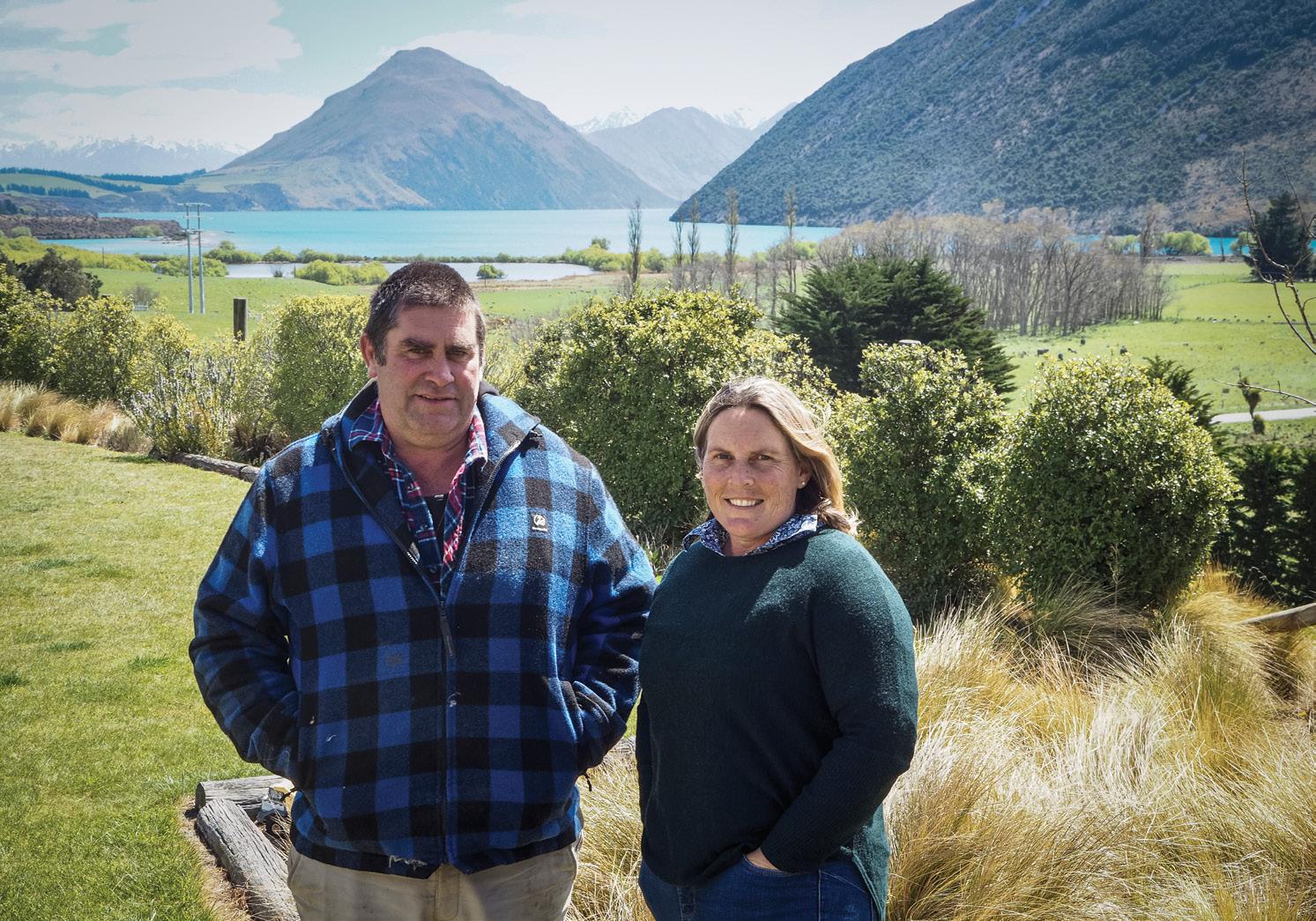
Again, to protect the soil, the plantain and clover is broadcast behind the drill which is used to sow the ryegrass, cocksfoot and lucerne.
Mark says he has been impressed with how each of the components have persisted in the pasture and this makes for a high-quality feed which is used for finishing lambs in spring and growing out replacements.
Since stepping into the manager’s role, Mark and Rebecca have made a concerted effort to keep on top of gorse, broom, wilding pines and horehound. The latter is particularly problematic as it contaminates the wool and is difficult to control, particularly when it gets into lucerne.
Deer and pigs are another issue, although thankfully the pigs don’t appear to be impacting on lamb survival.
Lake Coleridge Station has recently reviewed its animal health policy with a focus on reducing their reliance on drench.
“We need to get into a system where we’re not reliant on drench products,” says Mark
They have stopped using drench capsules and base drench decisions on faecal egg counts and regular body condition scoring.
As part of their strategy to manage internal parasites without relying on drenches, they are lifting cattle numbers to move from a sheep to cattle ratio of 80:20 to 60:40. To do this they are just tweaking their system to retain more cattle and sell more lambs as store rather than trying to finish them.
Across the three stations, they run 540 Angus Herford breeding cows and all R1 calves are retained and wintered on crops. The steers are sold to Five Star in spring and surplus heifers will either be sold as store or finished depending on feed availability.
Having gone through a spray and cropping programme, a recently developed 90ha terrace area will start producing significant quantities of high-quality permanent pasture which will give them more options and once shelter has become more established, this area will be used for multiple-bearing ewes at lambing.
Many of the water bodies on the station have been fenced off and a reticulated water scheme is soon to be installed, but Mark says there are no more significant capital development
projects in the pipeline.
Mark and Rebecca enjoy working with the Merinos. As a young shepherd working on McKenzie Country properties The Wolds and Maryburn, Mark learnt the breed’s idiosyncrasies and to appreciate what can be achieved given the right mix of genetics, feed and management.
He is now putting his skills and knowledge into practice, and along with Bruce and Kay, is getting the results they all want.
Getting the right balance of feeding, breeding and stocking rate, helped by a kind winter helped make a winning Merino clip.
bit of luck all played a part in the winning commercial clip at the Otago Merino Association Awards earlier this year.
First-time winner Charlie Hore of Patearoa Station says aside from the right feeding, breeding and stocking rate they were lucky with the weather due to a relatively warm winter that put sun on the backs of the Merino ewes.

“I guess we got the balance right. It’s taken a while, but we finally got there,” Charlie says.
He’s also quick to acknowledge the input of Patearoa’ s wool classers who present a consistent clip. Barbara Newton filled the role until her retirement earlier this year, and
Krystal Wilson has stepped up since.
Charlie has entered the clip of the year contest for the last six years and says he was surprised and chuffed to finally walk away with it.
“When you put the effort in for 12 months of the year it’s nice to get a pat on the back for a job well done.”
The commercial clip is based on the dollar return per head - the total value of the fleece only wool (exclusive of oddments) across the Merino flock (ewes, hoggets and wethers) –which generated a return of $85.38 per sheep in 2021.

Patearoa is on the smaller side of the fine wool systems throughout Central Otago and the Maniototo basin. It has a breeding base
of 3800 ewes descended from Stonehenge genetics. Charlie’s parents Jim and Sue established the Stonehenge Stud in 1969 with Merryville bloodlines which adapted well to the dry and warm southeast corner of the Maniototo.
Stonehenge, where Charlie was born and raised, is a two-minute drive from Patearoa. It’s been the cornerstone of the Hore family farming business since 1910.
Charlie, a Highlanders fly half in 20062007 explains that he was never expected to go farming but decided otherwise on returning home after seven years of international pro rugby in Scotland, France and Italy.
The opportunity to accommodate his farming aspirations came along when
neighbouring Patearoa came up for sale. It was bought in a lease-to-buy arrangement in 2011 and initially farmed as part of Stonehenge. In 2013 a block within the Patearoa boundaries owned by a local family was added creating a single landholding.
In 2016 Patearoa was split from Stonehenge for Charlie and Belinda, a former international netball and women’s basketball representative. At the same time Stonehenge ownership passed on to Charlie’s brother Andrew and wife Francine.
The brothers help each other when needed as does Jim who comes and goes between the two properties.
Andrew has the Stonehenge Stud from which Patearoa gets Merino rams, and Charlie
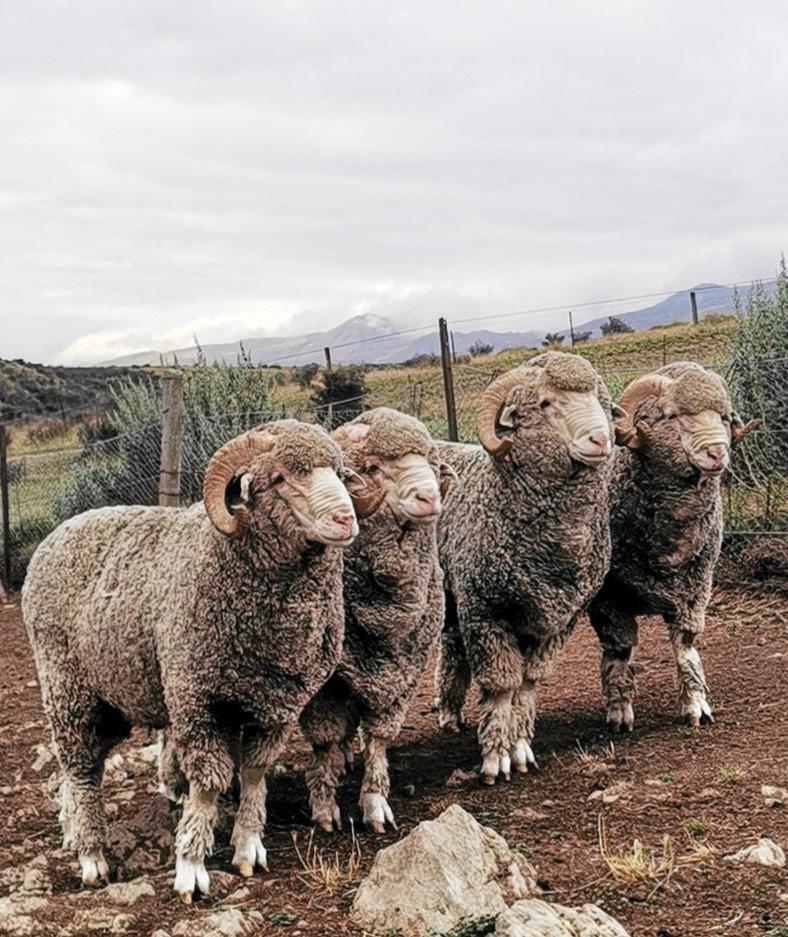
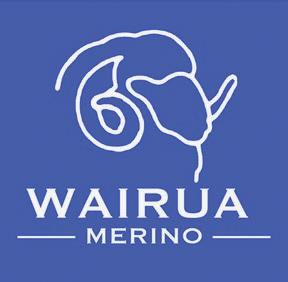

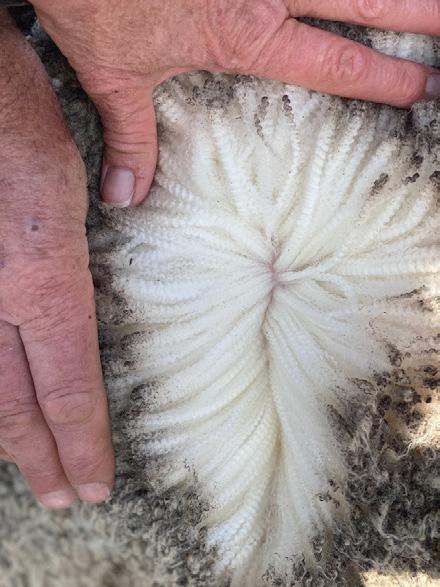

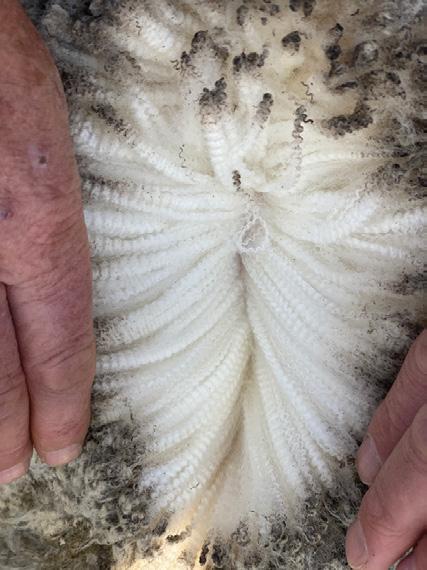

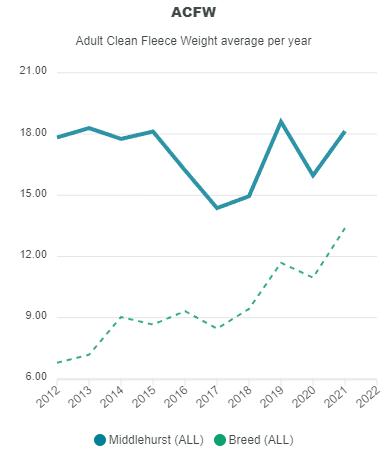
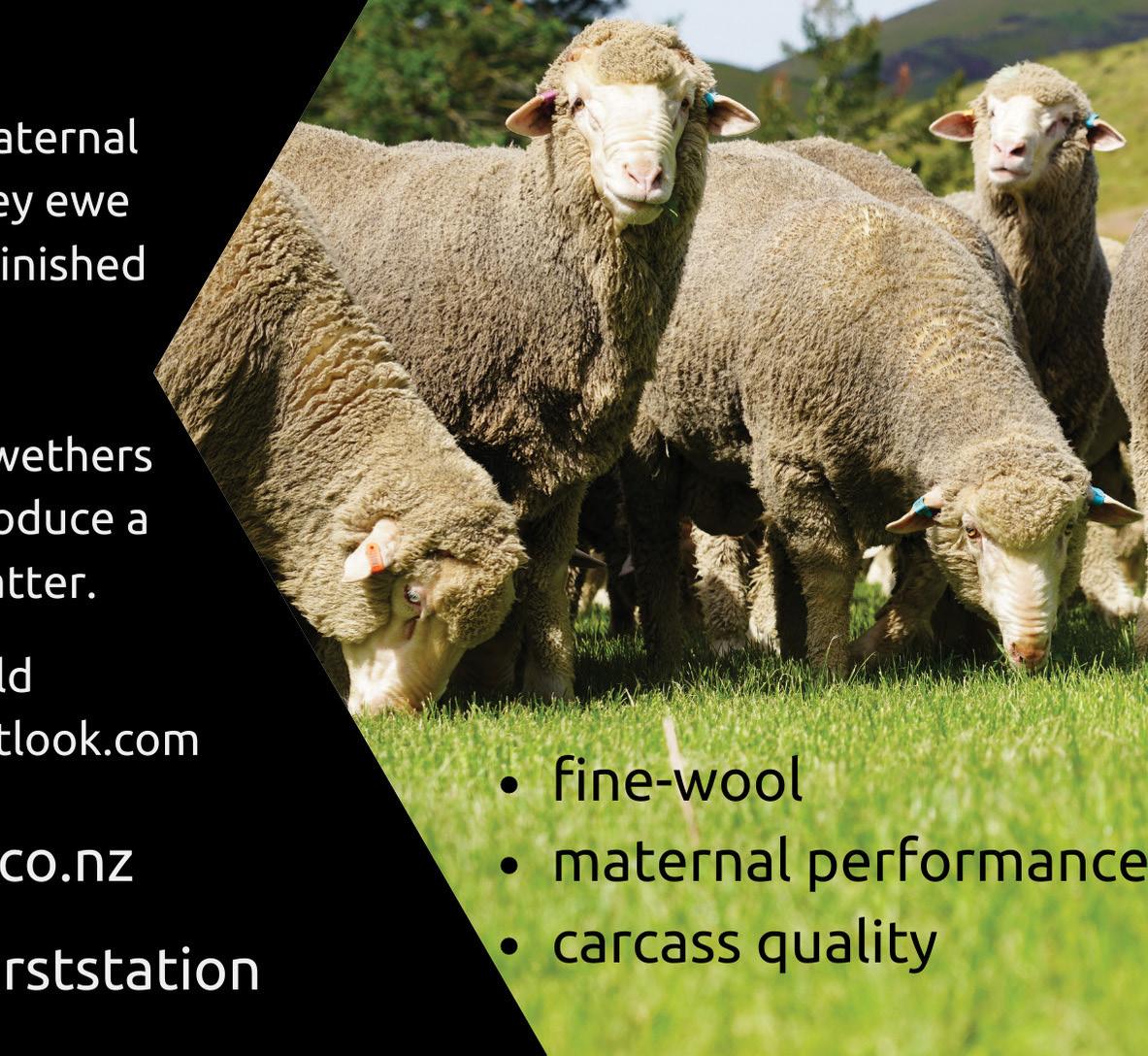


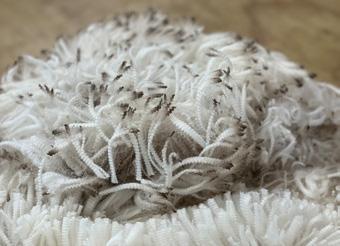
has a Romney stud supplying Romney rams for the halfbred flocks run on both properties. At Patearoa the 1000 halfbred ewes are mated to a terminal sire and the progeny finished and supplied to Silver Fern Farms. The Merino lambs are supplied to Alliance Silere contracts.

The main shear is in mid-August and this year the ewes clipped just over 15,370kg at 16.8 microns. The hoggets shorn in mid-September clipped 4790kg at 16.3 microns. The 2900 wethers clipped 15341kg at 16.4 microns. They’re low maintenance, spending all but shearing time out on the Rock and Pillar range, but high returning netting about $100 per fleece and another $140-$160 on the hooks.
The clip has edged finer which suits Charlie although he’s mindful about maintaining the right balance of weight, style and colour.
All of the clip is sold through Merino New Zealand contracts including Icebreaker, Loro Piana, and Reda as well as Glerup for the
crossbred wool.
Subdivision and irrigation have been the main focus over the last decade.
There’s been about 20km of fencing on the hill country to better use available feed. Over the same time border dyke and wild flood irrigation on the lower lying country, and some of the K-line above the main irrigation race, have been replaced by two Bauer pivots. The most recent pivot, watering 85ha, was installed in pre-winter 2022 keeping Charlie and farm employee Doug Smith busy over winter with subdivision fencing.
The irrigation investment has set up Patearoa for more reliable feeding and finishing along with the trading of lambs and cattle. A taster of the new opportunities was the grazing of 110 Wagyu weaners under a Firstlight contract. They arrived in December last year and grazed the irrigated area until May. Firstlight paid for animal health
Farm facts
Patearoa, 30km southwest of Ranfurly in the Maniototo basin.
Charlie Hore and Belinda Colling, and family Max (17), Peri (15), Ruby (13) and Marley (11).
8000ha ranging from 400-1465m asl.
7780ha of hill and 220ha of irrigated lowerlying country.
Fine wool, prime lamb, cattle breeding and Romney stud.
Rainfall: 350mm
Wintered stock: Merino 2950 ewes 2900 wethers 2400 hoggets 1030 Halfbred ewes and 280 Romney ewes.
150 mixed age Hereford breeding cows and calves.

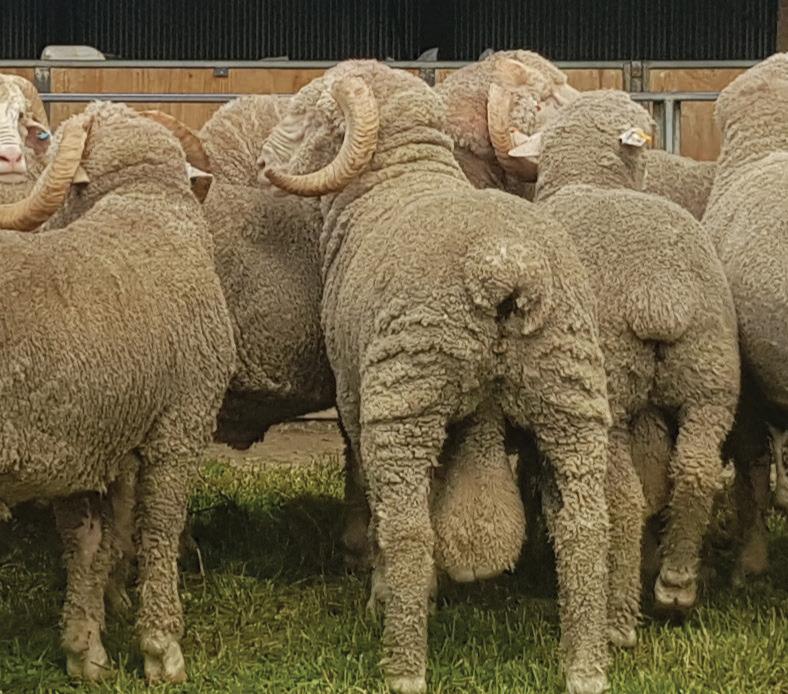
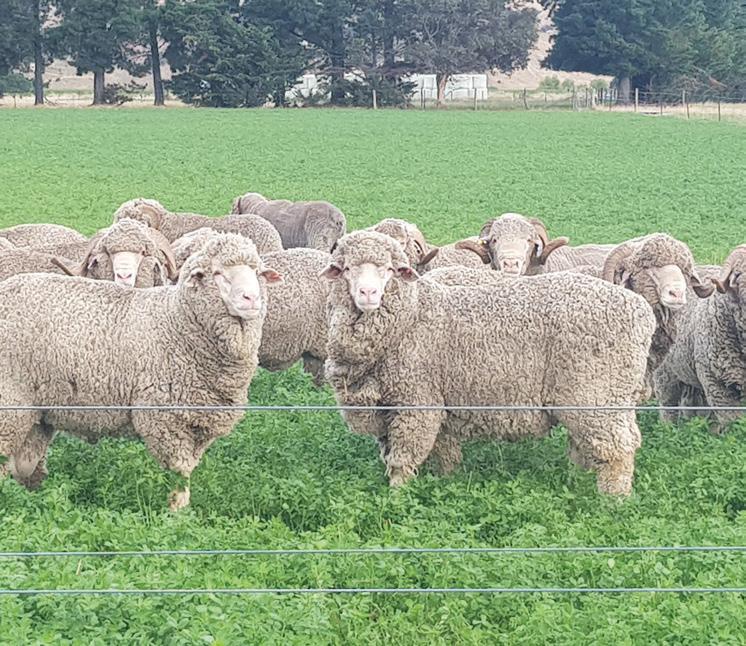

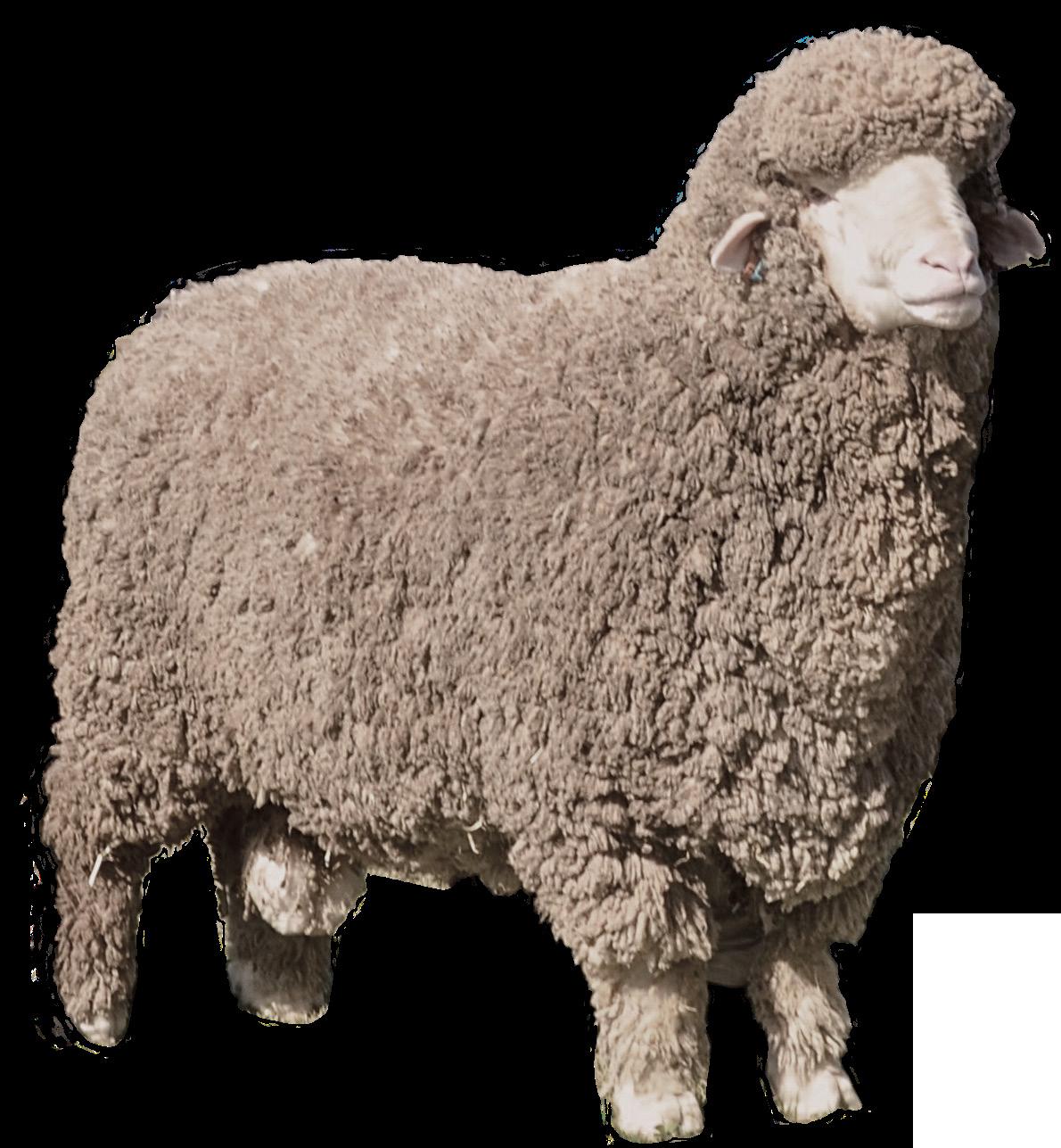
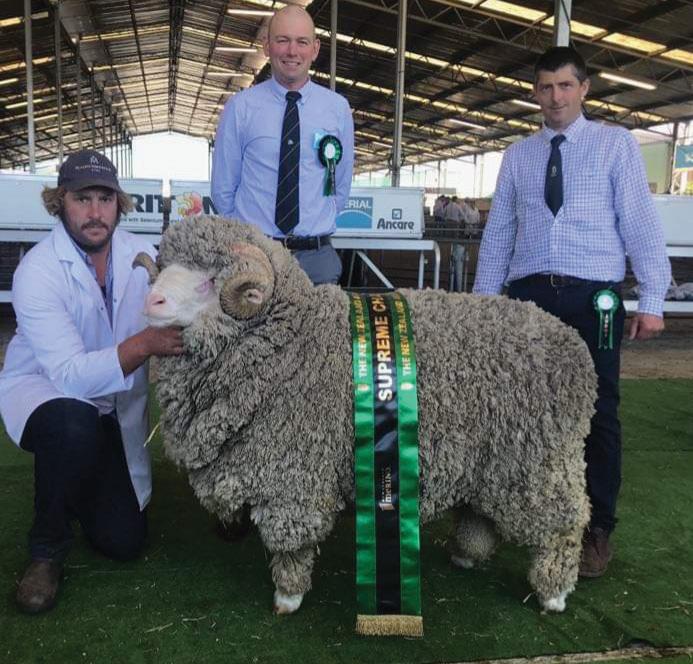
treatments, and overall the cattle were less of a hassle than lambs which would have required more monitoring and drenching, Charlies says.
The pastures under the irrigation include ryegrass, clover and chicory mixes and lucernebased mixes. The irrigated lucerne area also supplies balage for winter feeding.
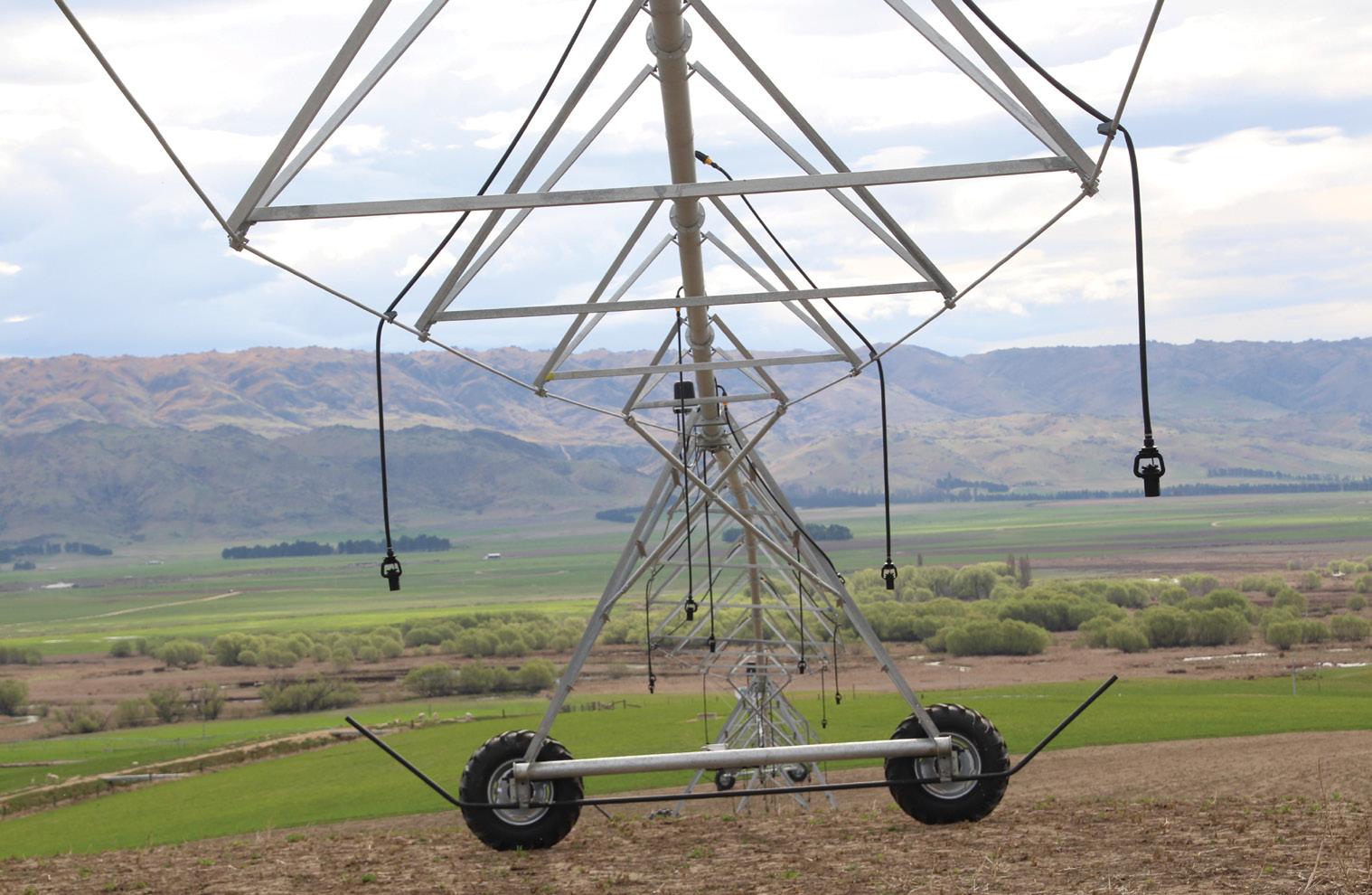
Patearoa is ideal Merino country, Charlie says, because it’s perfectly placed in the warmest corner of the Maniototo basin. Unfortunately it’s also perfectly placed for rabbits which quickly gained a foothold after release by the Otago Acclimitisation Society in 1863.


By the 1880s they were causing serious erosion and competing with the sheep for the sparse feed across the original 75,000-acre (30,000-hectare) run. The prevalence of rabbits in the area led to establishment of a rabbitcanning factory at nearby Waipiata in the late 1800s but provided little compensation incomewise to offset the damage to land and reduced sheep carrying capacity.
Patearoa employed rabbiters long before government-funded rabbit boards got underway in the 1940s. Shooting, poisoning and RCD virus have all helped over the years but the battle with rabbits continues. Nowadays they’re dealt to by shooters employed by Maniototo Pest Management, funded by about 80 landowner shareholders including Patearoa. About $20,000 a year is spent on rabbit control.
Briar and the hooked burrs of horehound, which contaminate the wool clip, are the main problem weeds. There is no quick fix for either, but regular spraying is helping beat back both.
Weed and rabbit control will always be on the to-do list, beyond that the priorities are to set up pastures under the pivot to maximise finishing potential.
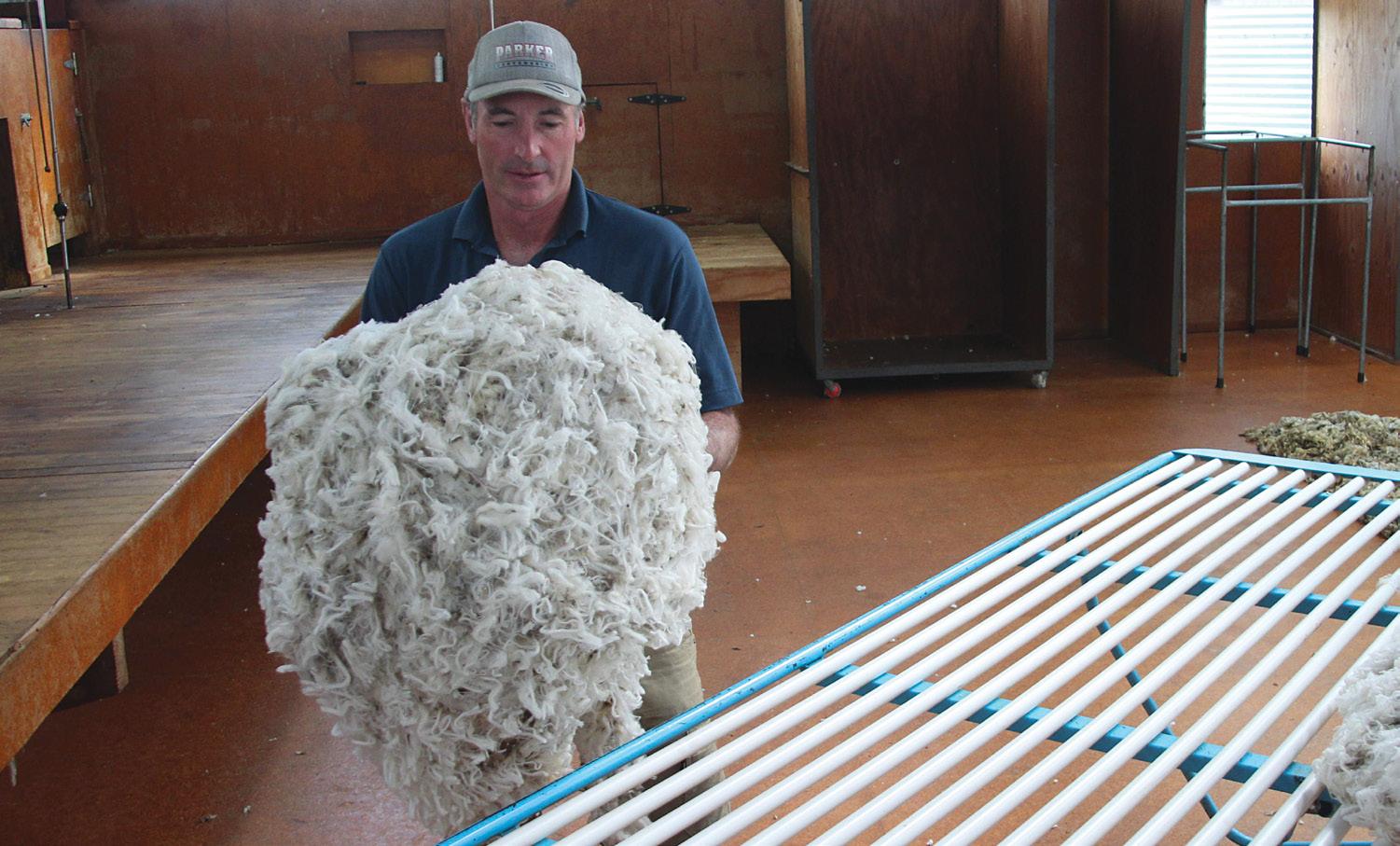
“I think we’re at the limit as far as capital stock goes so the opportunity is to get pasture and growth under the pivot for young stock.”
Internal parasite (worm) control is another focus area being worked on with help from North Otago vet Dave Robertson.
“I don’t want to go down the drench resistance hole but want to use less drench while maintaining production.”
That’s led to a number of preventative strategies and management such as faecal egg
counting to guide drenching, body condition scoring to ensure optimum feeding body condition scoring.
Although Charlie and Belinda have farmed Patearoa for little more than a decade the Hore family connection spans more than a century. Charlie’s great-great grandfather and first owner of Stonehenge helped out with mustering at Patearoa as did his son Chappie
and grandson Jim in later years.
Charlie’s great-aunt Rowena married Robert Beattie in 1945 and lived at Patearoa Station for more than 60 years.
The history of the land and the Beattie family, which owned it from 1910 until 2011 is captured in ‘Patearoa Station’ by Jim Sullivan. The book follows development and progressive subdivision from 1858 of Run 248 bounded by the Sowburn and the Upper Taieri rivers and the Rock and Pillar Range.
Alice information day, held on a Marlborough Merino property in August hosted by Vet Marlborough, with guest speaker Colin McKay of Elanco New Zealand, was very well attended.
Sales and merchandise manager Heath Dickson has been at Vet Marlborough for four years and has seen an increase in farmers asking about lice treatment options, particularly those farming Merinos.
Another trend is for one treatment per year. Previously, farmers would treat sheep with insect growth regulators over summer. This dealt to both blowflies and lice, and gave a second treatment for lice during the year.
“But due to resistance development in blowflies, we went away from it.”
Now Cyromazine and Clik are typically used at tailing or pre-weaning and, while great for fly, they are not targeted at lice.
“So we are very reliant on that one dip off shear.”
This can get a flock through, but only if the post-shearing treatment is really effective and no straggler sheep join the mob untreated.
Dickson suggests farmers monitor for lice in autumn, and consider another treatment then. He sells more product for use off-shears, than at weaning or in the autumn.
Farmers need to be aware of the potential issues with using pour-on products, rather than saturation. On cover-comb shorn Merino sheep, they are not guaranteed to work as well as non- cover-comb sheep, he said.
“No pour-on in NZ actually has a label claim for this, and typically, they are very vague when it comes to fine wool.”
He gives the example of Australian product, Avenge, which is a pour on with knock-down capabilities. The recommended dose for a
Merino is 80ml as a pour on, so it shows the high levels needed per sheep.
“I would always recommend plunge dip for Merinos, with high louse populations.
“The answer is saturation dipping with Extinosad or Seraphos if sheep have lice.”
Colin McKay works with veterinarians and animal health retailers across New Zealand. In his role with Elanco, giving technical advice, he has witnessed changes in farm management which have led to incomplete control of lice.
The first change has been a shift away from full-saturation dipping methods, he said, to low-volume methods such as automatic jetting races and pour-on products. This is to save time and treatment costs.
A key message at the Marlborough field day was that reading the back label of products is not enough to get information to base a lice control plan.
“Consultation with a suitably trained person is essential.”
McKay said labels are often based on data produced under Australian conditions, where they shear close to the skin, without a cover comb. This means pour-on directions ‘off shear’ based on Australian circumstances will be less effective on cover-comb shorn sheep.
Making an annual plan was a proactive way to treat a problem. Treatment timing and type should vary on the severity of infestation, wool length, products used prior, pregnancy status of sheep, he said.
As an example, in Australia, fine wool farmers may use pour-ons for three to four years then use a saturation dip, he said.
Up to 1994, all sheep were required by law to receive louse treatment annually.
Removing this regulation means lice have been forgotten and considered a low priority for some farmers (especially strong wool). Changes in shearing patterns and breeds used in coarse wool systems, also have an effect.

“Nobody really knows what programme shedding sheep need for louse control, but they do get lice,” McKay said.
Dipping via plunge dip was the best method for eradication and/or control. Some farmers are building new dips or opening up old ones, he said.
“Done properly, plunge dipping has the best chance of killing all lice on a sheep.”
McKay said that, given that
Elanco New Zealand colin.mckay@elanco.com
The sheep biting louse (Bovicola ovis) was once considered such a parasite of economic importance that annual louse treatments were enforced through legislation. Louse infestations are recognised as causing significant production losses in two ways:
1. Fleece damage: Lice cause intense irritation. Infested sheep bite themselves or rub against trees and fences, leading to fleece derangement, cotting or broken fibres. Lousy wool often has a yellow colour and a distinctive smell caused by skin secretions, causing further down grading.
Lamb parasite management plan on farms with loss of triple drench efficacy or capsule leakage.
Chemical class Brands
Organophosphate Seraphos
Propetamphos
Saturation
2. Hide damage: Lice can trigger an immune response known as cockle, which causes thickening of the skin and pelt damage. This allergic reaction usually occurs early in the infection process until the animal becomes used to the parasite
Unfavourable safety profile, resistance by lice very rare
Synthetic pyrethroid Wipe Out Vanquish
Deltamethrin Alphamethrin
BPU Insect Growth Regulator Magnum Zenith Diflubenzuron
Pour-on
One New Zealand study showed lice infestation in crossbreed sheep reduced wool yield and adversely impacted wool colour (Kettle and Lukies 1982a, Kettle and Lukies 1982b). An Australian study showed lice infestation in fine wool sheep reduced greasy and clean fleece weights and processing characteristics. A 2007 Australian model estimated lice infestations can reduce fleece value by $2.85 to $9.60/head depending on the level of infestation and micron (Liceboss).
Widespread resistance recorded in Australia and NZ in 1990s. Vanquish has claims for long wool emergency treatment
Saturation and pour-on Only effective against developing lice, resistance found Australia 2008, resistance status in NZ unknown
While Australasian studies have found not found any impact on animal liveweight, in one United Kingdom study conducted on coarse wool sheep, lambs treated with effective lousicide produced 34% more wool and had 18% greater liveweight gain (Ormerod and Henderson 1986).
Neo-nicotinoid Zapp Encore (combination with triflumuron)
Imidacloprid (combination with triflumuron)
Pour-on only Adds knockdown of adult lice to IGR
Macrocyclic lactone Cyrazin KO (combination with cyromazine)
Ivermectin Jetting only
History has shown that eradication, whilst theoretically possible, is difficult to achieve in commercial situations. Until 1994, it was compulsory in New Zealand to treat all sheep flocks for lice each year. Despite the regular application of extremely potent and long-lasting chemicals (e.g. arsenic, organochlorines and organophosphates), sheep lice are still prevalent in many flocks today. Modern control programs aim to reduce the size of the louse population to minimise economic impact rather than achieve eradication. These programs are based on an understanding of the life cycle of the sheep louse.
Knockdown control of lice. No known louse resistance. Claims for louse control in coarse wool sheep only
Spinosyn Extinosad, Expo Cyrex Spinosad Spinosad + Cyromazine (fly)
Figure 1. Seasonal patterns of louse populations on sheep.
Seasonal patterns of louse populations on sheep LAMBING
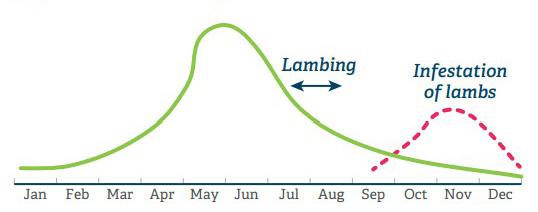
Saturation and pour-on Favourable safety, efficacy and residue profile. Short persistence in fleece.
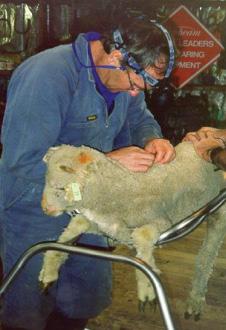
Shearing removes 50-70% of louse population depending on shearing method and wool type.
organophosphates have a low safety rating for use, it is best in hands of those who are skilled e.g. contractors with a portable dip. They are very effective against lice.
Spinosyn has good efficacy and safety levels, he said, and resistance has yet to be found to this class of chemical. This would make it a good product for a saturation or pour-on method. If saturation products are used, mix up product on the same day as use, with clean water. Check fleece is saturated.
McKay suggests a hoop jetter will work if at high pressure and a high volume per sheep. Jetting races need to be calibrated to make sure there is adequate volume per sheep.
Putting through twice can increase efficacy.
If jetting, he recommends checking water quantities per head by measuring the balance of a full 1000-litre tank once the first 100 sheep run through, to see how many litres are used/head.
The rule of thumb is two litres per sheep and half a litre for every month of wool grown, he said.
Research in Australia (Johnson, Dawson, Dixon 1996) using three automatic jetting races to treat long-wool sheep, showed in all cases, resurgence in lice numbers beyond 12 weeks after treatment. Fine wool sheep with short (4mm) or long (30-80 mm) wool and moderate
Best practice for confirming lice: Check three x 10cm partings at 14 sites on the sheep, with careful attention to the upper and lower shoulder. A headlamp can help. Courtesy Colin McKay.
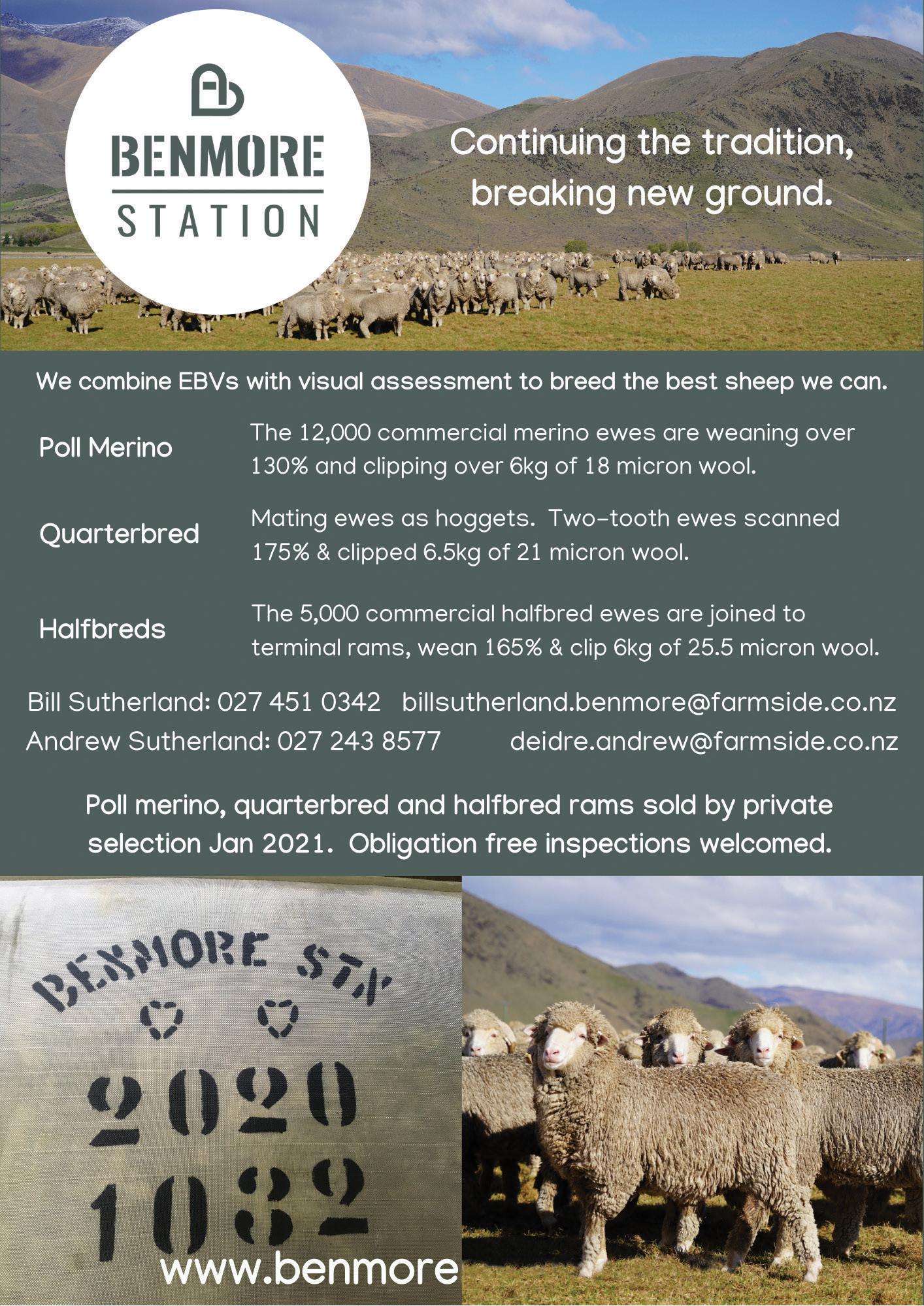

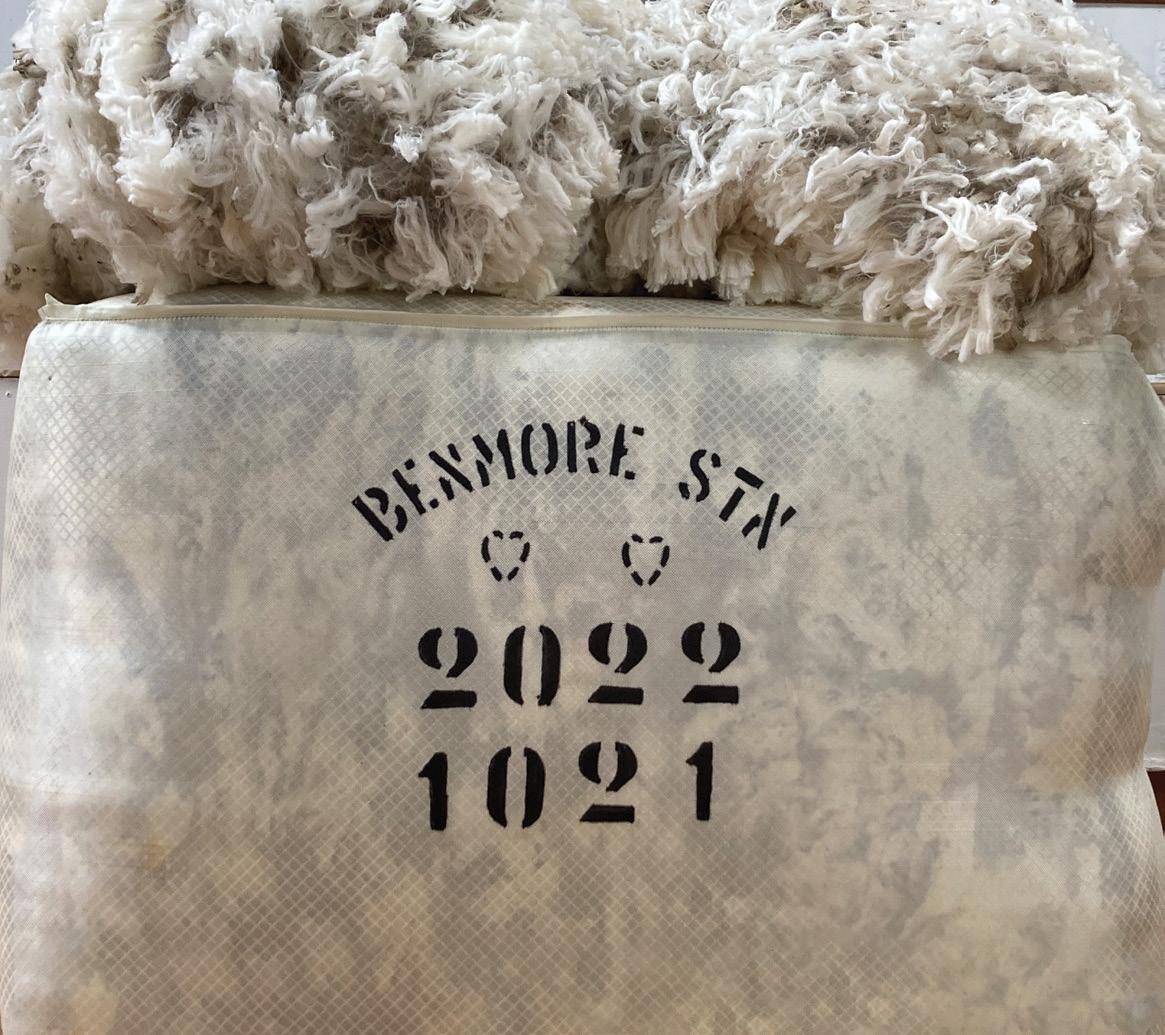
• Are surface grazers (they don’t suck blood).
• Live at the base of the wool fibres on the skin, where they consume surface debris. This can cause intense irritation and cockle on the pelt.
• Shearing removes 50-70% of lice with the fleece. When followed with a correctly applied chemical treatment, it is an opportunity for eradication.
• Immediately after shearing, grease flows from a sheep. Off-shears is the best time to treat with pour-ons, as the grease flow helps carry the active ingredients around the animal.
• One study found lice could survive for up to 10 days on shearers’ moccasins. Change clothes and footwear if recent contact with lousy sheep.
• Clean the shed of wool pieces (board and yard area).
• Treat bought-in/returned stock as though they are infected.
• Don’t forget to treat ewe hoggets, late prime lambs, rams and the dog tucker mob.
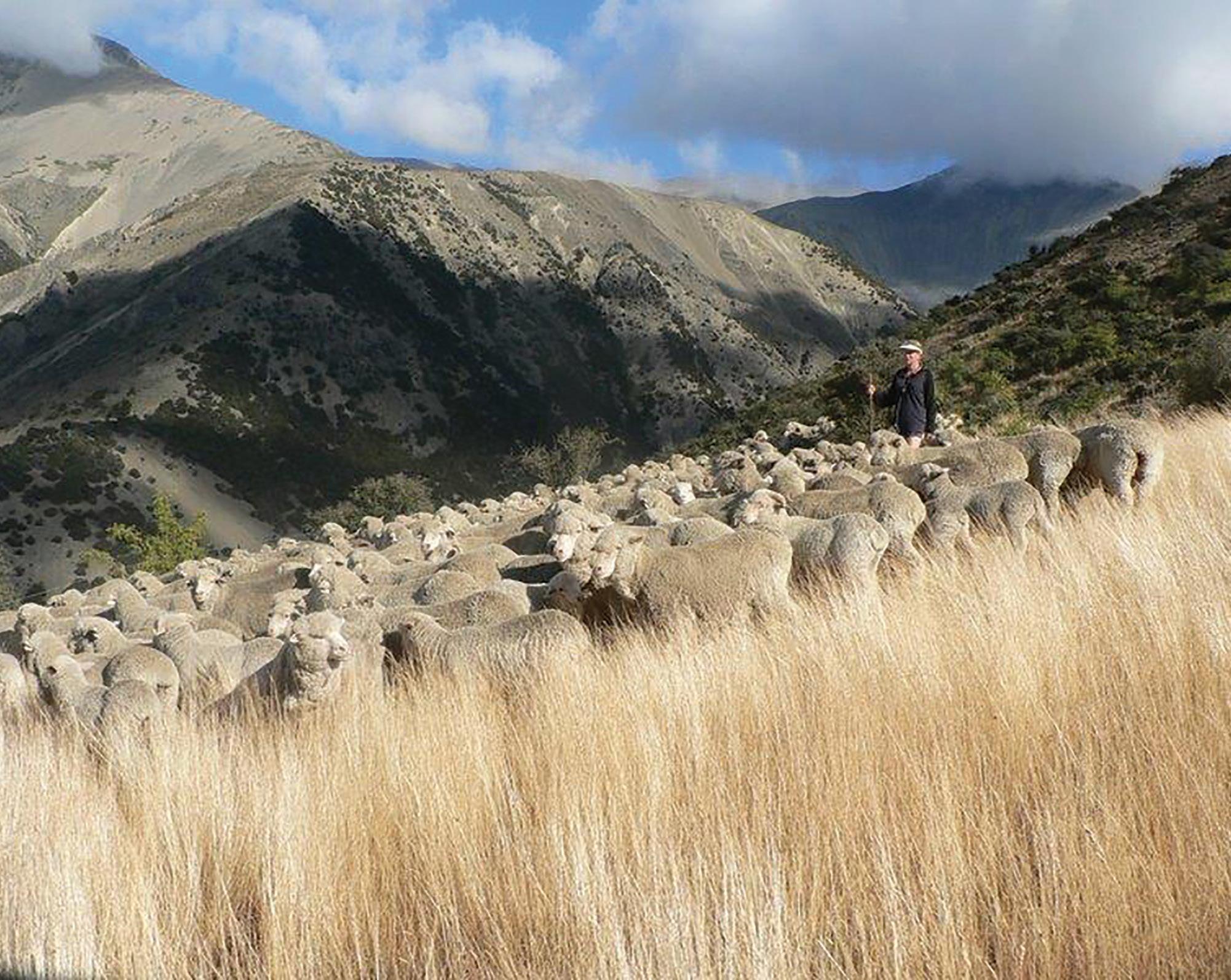
to heavy infestations of lice treated with cyhalothrin using Alison dip, Aussie dip and Boral Cyclone Superace jetting machines.
Results suggested that the jetting races tested would control infestations of lice for at least 12 weeks in sheep treated within two weeks of shearing, but eradication is unlikely.
Resistance to Synthetic Pyrethroids was reported to be widespread in NZ as long ago as 1997, McKay said.
Backline products must be applied strictly according to label directions and dose rates calculated for the heaviest sheep in the mob. Every sheep should be treated evenly along the middle of the backline, from head to rump.
Pour-ons are most effective if applied within 24 hours post shear. McKay recommends farmers must treat then, not wait until all the mobs are done and some animals have two- or three-months wool growth, or a more convenient time. This negatively impacts the results.
Farmers need to realise that BPU
insect growth regulators, diflubenzuron and triflumuron, the active ingredients in Magnum and Zenith, have no impact against adult lice, he said.
It’s important to have a chat to neighbours about an agreed policy on stragglers, he said. This might be that any straggled sheep are brought to the woolshed, and treated before being returned to a property, or put into a mob.
If treatment for flystrike and lice is required in the same year, use chemicals from different chemical groups.
Sheep lice cost the Australian sheep industry more than $120 million annually.
Lousy sheep not only produce about 10% less wool, but also further decrease wool quality value about 10%, plus the costs of chemical treatment.
For more NZ information see Managing Flystrike and Lice Booklet, Beef + Lamb NZ, 2019. McKay was a contributing author.
•
•
•
• ASBV’s and full recording information including muscle and fat scan available.
• Using industry-leading genomics to improve foot-rot resilience.
• Ideal for adding value to your sheeps’ performance.
• View Muller Station on Facebook.
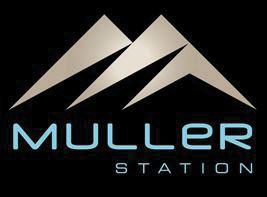
• Avoid parasites through the feeding of forages and planned grazing strategies.
• Feed stock better so they handle parasite challenges.
• Monitor parasite challenge and drench efficacy.
• Genuine integration of lamb finishing with cattle and adult stock.
• Leave some capital stock undrenched and graze them with or following lambs (refugia).
• Breed, feed and select for more robust animals that can handle a worm challenge.
• Strategic use of effective drench families and less whole flock treatment with long acting (LA) drenches.
Rabbits, hieracium and gorse are the visible pests in many fine wool systems, and drench-resistant worms the invisible ones. They’re out of sight so often there is less motivation to take early preventative action, North Otago vet Dave Robertson says.
But a plan on how to tackle drenchresistant worms, now a reality on many farms, makes all the difference. He works with a number of fine wool farmers, including Charlie Hore, to help develop effective control programmes.
In looking back at drench and worm management over the last 40 years he says the three traditional drench families (Benzimidazole, Levamisole and macrocyclic lactone/mectin) have served farmers well but are losing efficacy leading to noticeable
production consequences.
Triple drench resistance is now commonplace and likely to be present in the many store lambs traded this season. However, the production consequences aren’t immediately noticeable and typically manifest about April and May which Dave describes as the ‘hot months’ for worm and drench issues.
“The autumn conditions favour better survival and faster hatching rates of parasite larvae. Also, lambs have been drenched two to four times since weaning and are often going back into grazing areas that have had lambs previously.”

These are the ideal conditions for the emergence of drench-resistant parasites.
But a diagnosis of triple-drench resistance is not the end of sheep farming on the property, he says. Instead, it’s an opportunity to re-jig
Monitor FEC 10 FEC 10
Feb/March April
Pre-drench FEC 28 Post drench FEC 10 Pre drench
No refugia in mob.
FEC 10 = 10 day faecal egg count to check drench efficacy FEC 28 = 28 day faecal egg count to assess re-infection rate prior to drenching.
stocking policies, forage systems and review management habits and worm control.
“In most cases when changes are made the health of stock improves and so does productivity.”
The changes may not mean the end of triple drench use as the efficacy of drench fluctuates throughout the season and can vary on different parts of a farm.
“A (post-drench) faecal egg test at 10 days in February could show 95% efficacy, but in April or May the same test could show 50 to 70% efficacy. That doesn’t mean you can never use triple drench again because it still might be effective at certain times of the year.”
There does need to be a conscious effort to move susceptible parasite genetics through paddocks and mobs, using the principles of refugia where some animals are left undrenched. “That may mean buying in sheep with good drench status to repopulate areas with drench-sensitive parasites.”
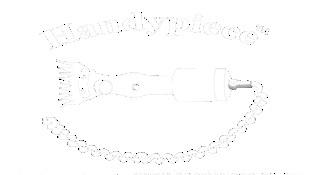
Dave has worked with lambing finishing blocks that have brought triple drench back
from zero to 95% efficacy in three years using these sustainable drench practices.
Breeding and feeding can play a big part in reducing the worm problem.
“The mundane truth is that better-fed ewes in better body condition don’t suffer the effects of parasitism the same. “
Selecting for more fat and carcase weight will lead to a more robust sheep that can handle parasite challenges and require fewer chemical inputs, but they are a “higher octane” animal that to truly perform need higher-protein forages.
Feed management also plays an important part, especially the integrated grazing of lambs and cattle. However, ‘integrated’ grazing is often not applied as intended. A farm might be described as an integrated sheep and
cattle system but in practice not run like one, with the sheep and cattle grazed separately. Genuine integration for successful worm management means using cattle to follow lambs to clean up pastures.
“It takes more planning and work to do this, but it can really help with parasite management.”

The two newer drench families (Startect and Zolvix) are new tools for farmers which will remain effective so long as their use is carefully planned.
“The industry is very fortunate to have these options available. They are more expensive than traditional drenches, but there is nothing more costly than an ineffective drench where stock eat good feed, don’t grow, then start dying.”
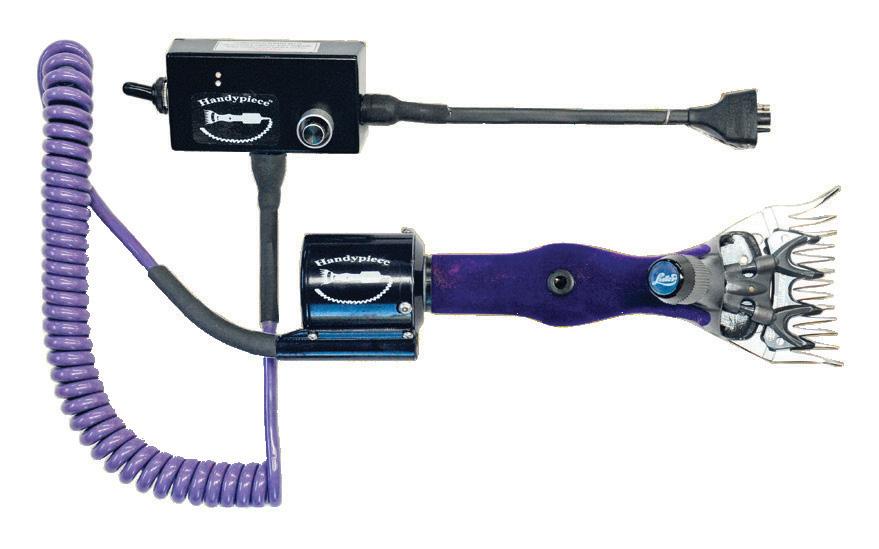

boosting the lifetime production of Merinos through optimising nutrition from conception through to culling.
This reinforced Mark’s interest in fine wool sheep and he followed his degree up with a PhD in Merino genetics at Murdoch University in Perth.
His knowledge and skills came to the attention of the New Zealand Merino Company and he worked as a consultant for the company before he shifted his family across the Tasman in 2012 to work for the company on a permanent basis.
In 2018, he started neXtgen agri which now provides consultancy services in every state of Australia and throughout NZ.
“This includes helping with data management, genetic decisions and sourcing genetics, anything to do with breeding,” Mark says.
Over the past decade, he has noticed a significant increase in the number of fine wool producers making use of genetic information such as Estimated Breeding Values (EBVs) in their ram selection criteria and he believes there is scope to make even more use of these to lift productivity.
“We now have values for lamb weaning rate and we see a huge variation in this trait, as much as 40-50%, so there is a lot of opportunity to improve in this area.”
AS THE WORLD MOVES AWAY FROM its reliance on plastics and synthetic materials, animal production scientist Dr Mark Ferguson believes natural fibres are about to enjoy their time in the sun.
His mission is to ensure the sheep industry is well poised to take advantage of this reversal in fortunes and while Mark’s name is most commonly associated with fine wool sheep, particularly Merinos, his company neXtgen Agri, provides genetic and data management support and advice to farmers running sheep and cattle of all breeds.
Now based in Christchurch, Mark’s interest in breeding and genetics began at a very early age growing up on a mixed-cropping farm in North west Victoria.
At the age of 12, he was breeding Angora goats and a few years later, added Poll Dorset sheep to his breeding enterprise. By the time he was 18, Mark and his brother owned the farm’s almost 1000 Poll Dorset ewes and Angora does.
Mark attended university in Melbourne then became involved in the Lifetime Wool project which looked at
He admits the majority of fine wool producers are farming in tough environments and weather will always be an issue, but even on the roughest days there will be lambs which survive and part of this is genetic.
Mark says the dial has shifted significantly on survivability in fine wool sheep and there are producers who are weaning 140% to the ram, on a par with crossbred and strong wool breeds, but this is as a result of looking at a range of traits, not just fertility.
“The move to positive selection for fat and muscle in the Merino ewe has underpinned this forward momentum in Merino weaning rates.
“If you can get the carcase, the feet and the skin right you can close that gap a lot.”
The foundation has been laid in proving the value of tools such as EBVs and data to help drive genetic gain and address issues such as footrot and this is a strong platform from which to look at other health and welfare traits, he says. These include internal parasites and dags as well as carcase attributes.
“The Merino’s primary purpose will always be to produce quality wool but if you can balance that with other traits, then it becomes a much more farmable and profitable breed.”
A focus on genetics has lifted Merino productivity as wool and other natural fibres enjoy a revival in place of synthetics, Sandra Taylor reports.
Every week, Mark Ferguson and his team at neXtgen put together the Head Shepherd podcast which taps into the stories and wisdom of some of the best brains in the livestock, genetics and innovation businesses.
They then make it freely available to anyone with interest in the livestock industry.
The podcasts are a mix of practical livestock management, such as improving reproductive performance in maiden ewes and replacement ewe selection through to Agtech Innovation and thinking outside the box.
The Head Shepherd podcast is available on all major platforms.
Essentially it is about breeding a sheep that will perform well in an environment where animal welfare issues are increasingly under the spotlight and skilled labour is getting increasingly difficult to source.
“We’ve seen a big change in the past 10 years with most rams being sold with some data with them.
“As a result of this we are seeing massive shifts in production.
“Fine wool is leading other industries as far as data usage is concerned.”
To use data, it must first be collected and Mark has been instrumental in developing a piece of technology that could prove game-changing in identifying top performers in commercial ewe flocks.
Throughout his career, there has been a big focus on ewes and identifying the ewes that are the most productive and reproductive, Mark says.
On a commercial scale, it is impossible to identify which lambs belong to which ewe and this hinders the opportunity to find the best sheep in the mob.
He has tried using sensors, collars and tags over the years, but could not get them to work at the scale and simplicity necessary to operate at commercial scale.
He is now going down the line of facial recognition to identify which lambs belong to which ewe when they are in the paddock.
Four engineers are working full-time on the development of an Artifical Intelligence-equipped camera, which, when set up in a paddock, will take images to identify a lamb’s unique facial features and link it to its mother.
As well as his own time and money, Mark and his team have received support from Callaghan Innovation as well as farmer investors to develop the technology which should be commercially available next year in time for the Australian autumn lambing.
He admits the technology is ideal for Australian conditions with their flat paddocks, but even on steeper terrain, which is where Merino ewes are typically run in NZ, there will be areas such stock camps or water sources where ewes and lambs will be passing through
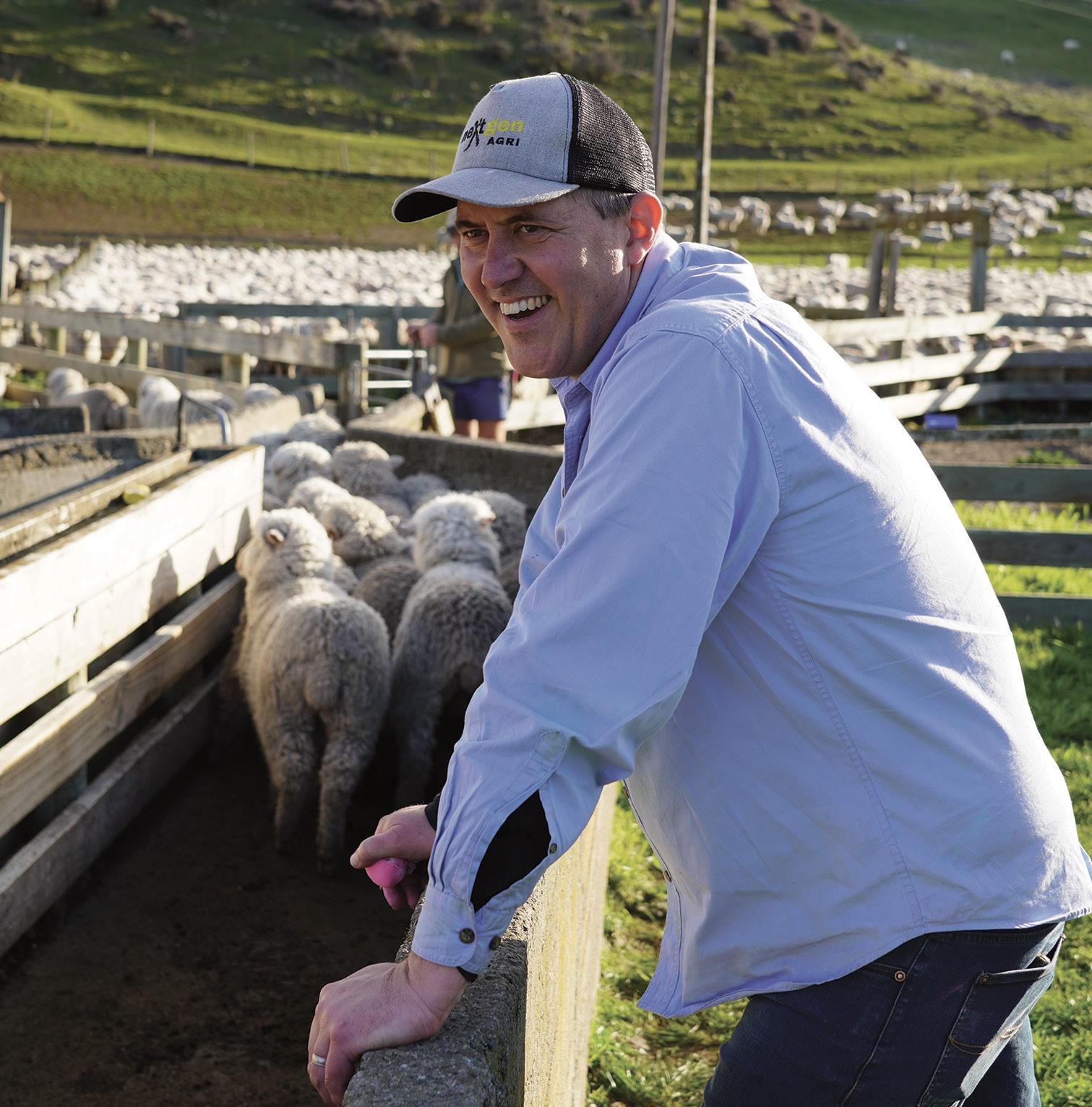
daily allowing images to be captured.
“It’s like having a permanent shepherd in the paddock monitoring animal health and welfare. We are training the camera to see what a shepherd sees.”
Having the ability to identify the progeny of the best-performing ewes will allow commercial farmers to make significant progress in the productivity of their ewe flock.
Using genetic tools to improve Merino’s carcase traits and lamb survivability while reducing some of the costs associated with sheep, such as drenching and dagging, will increase the productivity and profitability of Merino flocks.
Mark’s optimism about the future of fine wool sheep is well-founded. The fibre is increasingly sought after by big corporates looking to use wool as an alternative to synthetics and this is reflected in the long-term supply contracts many NZ fine wool producers enjoy. The Australian auction market has been a bit variable lately, but generally that market has also been very solid.
There is a lot of interest in securing wool that meets the welfare and environmental credentials required by the top end of town and he believes genetics holds the key to continuing to produce wool in a sustainable and welfare-friendly way. The future for the breed looks very bright in a world reawakening to the attributes of fine wool.
“The Merino’s primary purpose will always be to produce quality wool but if you can balance that with other traits, then it becomes a much more farmable and profitable breed.”Animal production scientist Dr Mark Ferguson.
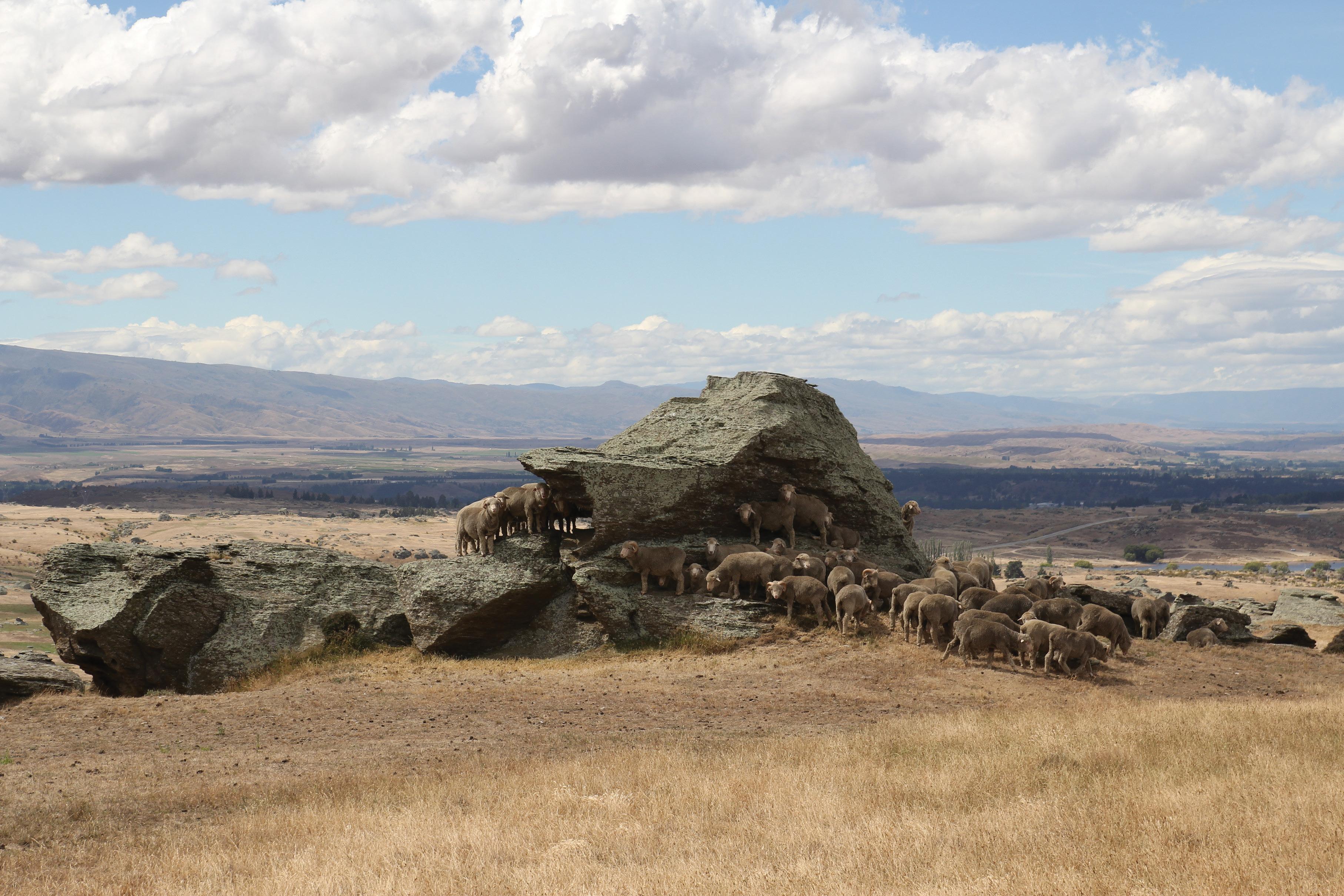
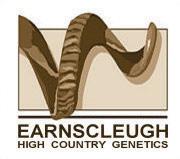

Nine Mile has two out of the top five NZ Merino Sires in the Dual Purpose Plus index.
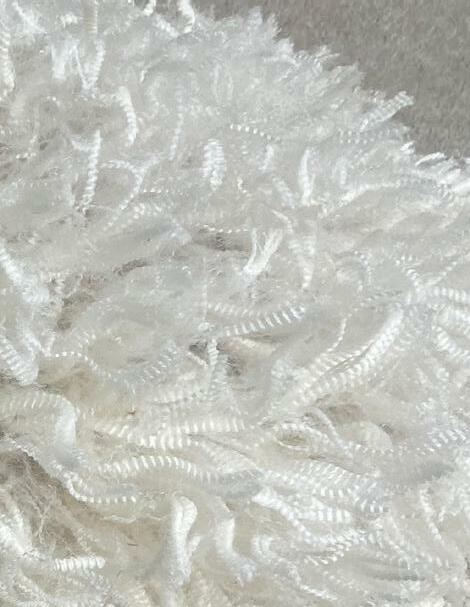


“Mt Pisa Station runs 11000 stock units and switching to Nine Mile Genetics was a game changer for us. We went from a traditional merino flock to a genuine dual purpose one with increased performance in all aspects. Nine Mile Polls were the first to use ASBVs and introduce carcass traits and this technology helped transform our flock.”
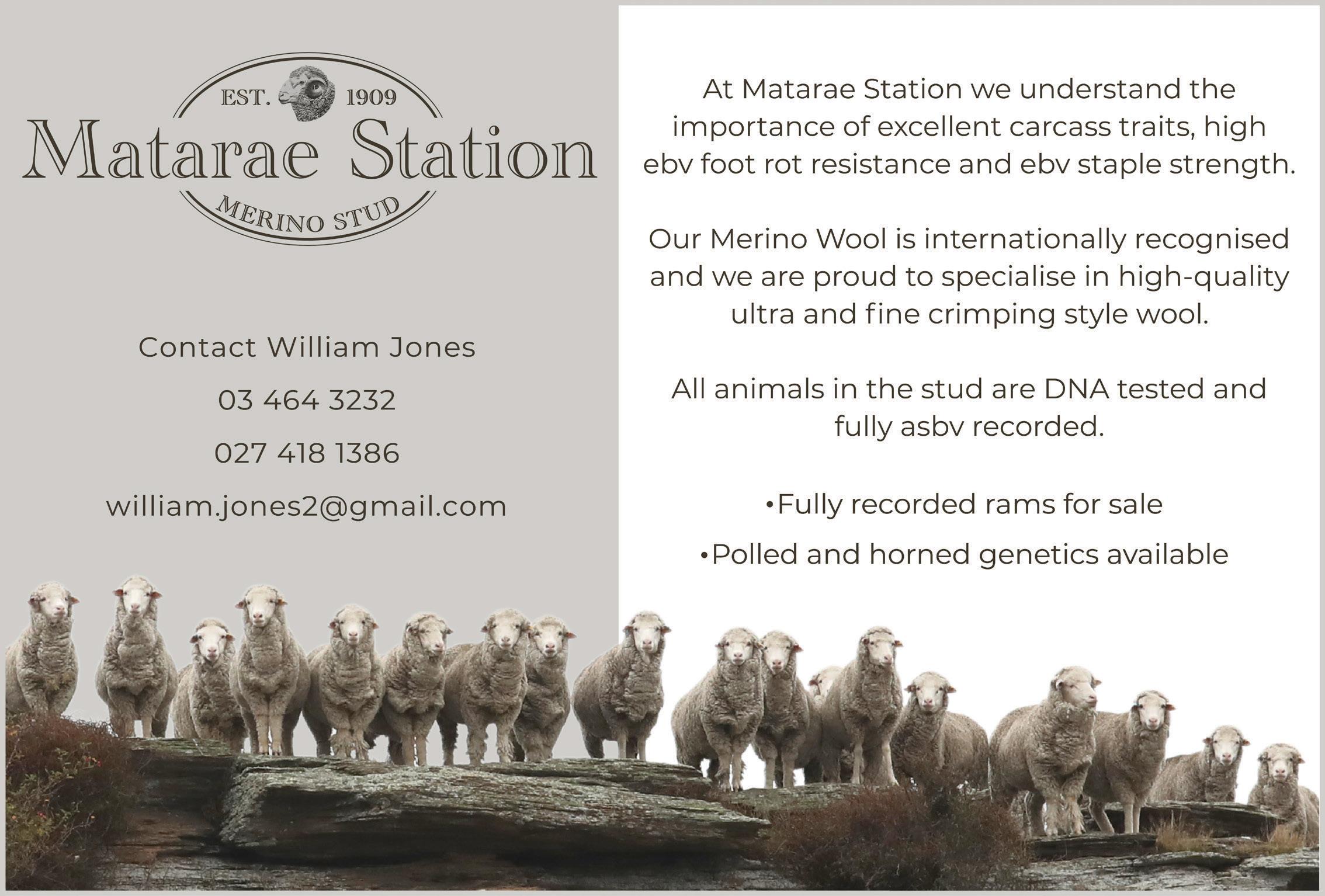

 Shane MacMillan,
Shane MacMillan,
Mt Pisa
Station“The phenotype, structure and EBVs of Nine Miles Poll ram genetics have helped us reach our on farm targets. We are now killing up to 80% of our merino wether lambs before winter and have achieved 128 – 132% lambing over the past three years, ewes to ram weaned. Cumulatively this lift in performance has contributed significantly to our bottom line.”
GundyAnderson, Bog Roy Station
“Nine Mile Poll Merino X Cordyline Southdown lambs drafted in February averaged 19.5kg carcass as part of a terminal sire progeny testing program here at Cordyline Southdown Stud. The Nine Mile ewes were fantastic progeny testing ewes. They scanned 177% for first cycle, they had strong maternal traits, good lambing ease, milked well and the wool cheque was pretty handy as well.”
Dave Robertson, Cordyline Southdowns
Liberating fine wool growers from the auction system for setting their clip’s value is John Brakenridge’s personal highlight from nearly 27 years as The New Zealand Merino Company’s (NZM) chief executive.

He steps down from the role in a few months, content that he’s led a revolution of positive change within the fine wool sector.
“To be able to connect growers to brands, establish long-term contracts, and build on that for the past 25 or so years, is something I’m immensely proud of,” he says.
Challenging tradition and changing the Merino model took courage and determination, especially in the early years when he copped plenty of flack for daring to question tradition.
“Everyone challenges you and says you have to do it this way. But we knew it had to be a whole complete rebuild of an industry,” he says.
Contract were initially seen as radical and risky. Now, it’s accepted as a game-changer.
“It’s hard to think of a single (contract) default since we started because every contract has such a deep sense of connection and relationship.”
Giving growers price certainty, something they couldn’t always guarantee when selling wool either in the shed or at auction, has revolutionised the sector.
An early success story was the young couple who were struggling to take over their family farm.
“When we were able to introduce contracts for supply, that gave them certainty of price which the banks were able to gain comfort from.”
“That same couple’s son is stepping into the family farm 25 years on and it looks like their daughter will do an internship with us. That is the sort of thing that gives us huge satisfaction
that we’ve made a difference for them.”
He’s reluctant to single out brand partners who have made NZM more successful. But three early partners to sign up were John Smedley, Icebreaker and Smartwool.
“We wrote the first contracts with John Smedley and although Icebreaker and Smartwool were very small back then, they were so important because by working with them, we were able to define a whole new activewear category.
“A lot of people forget that apparel wool was like strong wool is now for the carpet sector. It had been almost entirely replaced by synthetic and cotton.
“So those early contracts we developed with Icebreaker and Smartwool created a whole new category in that active outdoors area, something people said couldn’t be done,” he says.
Another influential early supporter in NZM was Pier Luigi Lora Piana who has just been in NZ to celebrate 25 years since he signed his first contract.
He pioneered the ground-breaking use of 90-110mm, 18.8-micron wool in their Zealander fabric 25 years ago, opening up the opportunity for these longer wools. To this day, it is still a feature in the Loro Piana fabric range.
Using this fibre, Pier Luigi produced the first waterproof wool jacket (called the Defender), which was worn by the NZ America’s Cup team.
Other standout brands that have supported strongly for many years are Italian firm Reda, German wool spinners Suedwolle, and Nikke from Japan. Reda and Suedwolle own farms and supply their wool through NZM to other brands, demonstrating the depth and breadth of the partnership ecosystem.
The early successes gave Brakenridge and his small team the confidence to continue growing and adapting.
“It’s okay now in hindsight, but in the moment, we had so many forces working against us and it was gruelling.
“Remember there was only one or two of us, and we were from outside the wool industry, and nobody was really enamoured by what we wanted to do.”
A turning point was the support of many growers who chose to support NZM. Their support was often in the face of threats from other players in the sector to boycott their clip if they sold even one bale through NZM.
Coming from the horticulture sector and being able to see the sector through ‘fresh eyes’
was an asset for Brakenridge. Rather than be hamstrung by historic thinking, he insisted on a more strategic vision for the company which allowed him to develop a view of where NZM needed to be positioned three years out.
Given the small team, he personally led much of building confidence in growers and brand partners to stock with the vision.
“It was like no tea breaks, don’t blink!”
He also credits the growers for insisting on bringing on independent directors to
the NZM board to ensure it had the right balance of skills to support and challenge the management team.
“The growers brought in that diversity and independence of thinking and that has always been a big part of the business.
“We quickly found they are not conservative people from the high country of NZ. Their pioneering spirit and attitude really came out to back our disruptive, new approaches.”
Ahead of the curve is where Brakenridge has always aimed to position NZM.
A recent example is the development of the new regenerative farming index (RX) which has already been adopted by hundreds of growers farming millions of hectares of land and livestock.
“Our growers might have wondered what regenerative farming meant for them, but they reasoned with the discussion and have really signed up to our RX approach.”
“Now our growers are saying we’re pleased we’ve got this because we’ll be in front of the curve.
“Now we’re identifying our carbon numbers and getting recognised for our biodiversity, not being washed along by other industries, and it’s in a way that’s recognised by the market which is hugely critical.”
Brakenridge says too much of the NZ primary sector is operating in defence mode where they protect what they have rather than leading customers and partners to where they need to be.
“The collective leadership in NZM has always been how do we front-foot this? How do we lead this? And, how do we connect through to markets around things that are inevitably coming at us?”
He’s delighted with the RX uptake by growers and says it will ultimately help them be recognised as a solution which is rewarded and celebrated in a positive way.
“They are natural conservationists. They’ve had to have been that over generations. But now we have the stories backed up by the science too.”
The New Zealand Merino Company’s (NZM) outgoing chief executive John Brakenridge is coy when asked what his next move will be.
More family time is a definite priority, but just like the long-term contracts he has helped to engineer for growers, he will always remain connected primarily to agriculture in career terms.
“My passion has always been for agriculture and moving forward in that value space is where I want to remain.”
He wants to continue building trust and respect for Te Hono, the agribusiness leadership development movement he established a decade ago in collaboration with Stanford University.
“We had an amazing (Te Hono) event in September and I want to continue providing ideas for that in the future.”
For NZM, he is content that his time at the helm is up following three years of successive record profits through a challenging period with the Covid pandemic.

“We’ve got an amazing team of nearly 60 staff now, and I’m so pleased that we’ve been able to attract great people to the business who probably wouldn’t have considered a career in agribusiness.
“They are smart graduates, they’re passionate about the business and the sector. You can’t do anything superficial when you’re tackling big issues like zero carbon. It all
requires a big investment in people.”
Before he departs the role, Brakenridge expects to see a new technology platform launched by NZM, developed in a joint venture with a Silicon Valley company to reduce the burden of compliance for growers. It uses satellite imagery to help growers identify opportunities and will link into their RX index.
There’s more work to do in the strong wool space where NZM has been increasingly active. He’s buoyed by early successes with brands like Swanndri, Glerups and Bremworth to develop longer-term supply contracts, but says the premiums for growers are not good enough yet.
MORE THAN 500 GROWERS ACROSS more than two million hectares of land have signed up for the New Zealand Merino Company (NZM) regenerative wool platform since its launch in 2020.
Through ZQRX, NZM is providing extensive grower support and taking a holistic view of farming practice.
The ZQRX programme measures the positive animal, environmental and people outcomes seen across the grower base, at a meaningful scale. The RX, which sits behind the ZQRX programme, measures and encourages improvements through 15 key performance indicators across animals, environment, and people.
ZQRX goes beyond sustainability and focuses on meaningful actions that will contribute to improvement across the whole farm system.
For NZM, regenerative agriculture is much more than a set of farming practices, it is a mindset and management approach that gives back to the land and communities that farm them. ZQRX is a collaborative action platform, connecting brands and growers, helping to encourage and reward onfarm improvement.
Together, world-leading brands and ZQRX growers are working towards the mutual goal of leaving this planet better than they found it.
The focus through 2022 has been on
quantifying the work ZQRX growers are undertaking across the key performance indicators for climate, land and biodiversity.
This has led to partnerships with Silicon Valley-based tech company Actual, the Savory Institute’s Land to Market programme, local leading soil consultants Soil Matters and the new and upcoming Eco-Index. These partnerships all focus on increasing support and tools for growers and measuring the significant progress that is already happening onfarm in these areas, in order to add value.
NZM has recently announced their collaboration with technology gurus, Actual. As a first output, the NZM collaboration with Actual has enabled measurement of a carbon number for every ZQRX property.
This is the initial step in not only reducing onfarm emissions but measuring sequestration too.
Through NZM’s partnership with Actual, they have already modelled native vegetation sequestration, and plan to model multiple mitigation options so each grower will be supported with strategies to reduce their carbon footprint that are specific to their farm.
The partnership between ZQRX and Actual is rooted in measurable impact – the ability to model mitigations on farms will guide future investment and equip NZM’s network
of growers with tools to action positive environmental impact.
In June, NZM and Savory Institute’s Land to Market Programme announced a strategic partnership between the two organisations. This partnership will drive outcomes within the Land Indicator of the ZQRX platform, incorporating Savory Institute’s Ecological Outcome Verification (EOV) protocol as a key quantitative measure.
The first output of the partnership is holistic management training and subsequent EOV assessments on over 30 farms this year. The EOV will be used as a tool to help understand the natural resources on growers’ farms and provide advice to support improvement to create sustainable, resilient farm systems in line with their goals.
As a foundational partner of ZQRX, VF Corporation is providing significant investment towards the EOV assessments, a testament to the value they place on their relationships with the farming community in NZ.
The Soil Matters team will be completing the on-the-ground EOV work.
Soil Matters is a soil consultancy company based in Christchurch, helping growers with independent soil health expertise, including soil testing, advice on nutrient use and

agronomy advice. The Soil Matters team has recently been trained to deliver the Savory EOV.
The EOV assessments provide validation to the market about land health across the ZQRX network, and they give confidence to growers that their management is contributing to positive land health outcomes.
To support quantification and investment into biodiversity on farms, NZM is collaborating with the Eco-index to improve understanding of the type and quantity of ecosystems across the ZQRX platform of growers. The Ecoindex is using remote sensing technology to build new tools that will generate information to help protect, restore, and connect our native ecosystems.
Using machine learning to scan satellite imagery, the eco-index will provide information on ecosystem type and extent across the ZQRX platform, how much land is regenerating back to native ecosystems and what level of investment is needed to improve it. This will provide guidance for restoration efforts, including which ecosystems are most at risk. The tool will help support decisions to improve biodiversity and supply evidence to our consumers about the positive impact our wool growers are having on their land.
Climate, land and biodiversity are NZM’s first areas of focus within the ZQRX programme. However, strategies and technology to support the other key performance indicators will be following these advancements, to capture and reward all the good work growers are doing across animals, the environment, and people.
As science and technology evolve, NZM’s goal is to support their growers to do better in the areas that are important to them, the markets they supply, and the regulatory environments they operate in. So much incredible work is happening in the wool-growing space in NZ, and capturing, measuring, and then adding value back into these communities to reward this work is of the utmost importance to the ZQRX programme.
Supplied by New Zealand Merino Company.
A SCHOLARSHIP PROGRAMME HAS been established this year to support female Lincoln University students to pursue careers in the wool industry.
The Ann Scanlan Scholarship pays tribute to a passionate high-country farmer who serves as a fantastic role model for young women working in the farming industry.
Ann first honed her stock and dog skills as a young shepherd at Tautane in the North Island, and from there she pushed the boundaries in farm management, sheep handling and wool production.
Following her shepherding stint, she was recruited by John and Heather Perriam, of Bendigo Station, to manage Otamatapaio Station, which they bought in partnership with the Botto family from Italy and the Lempriere family from Australia.
The Botto family were initially sceptical about appointing a woman to manage their investment, but Ann soon proved them wrong with her dedication to the property.
The three families eventually bought Rugged Ridges in the Waitaki Valley and Glenrock Station in the MacKenzie, with Ann moving into the general manager’s role and overseeing the three properties.
Francesco Botto said he and his relatives would always be grateful for the job she had done.
“Ann has been an important person to the evolution of our farming in New Zealand. She took on a big challenge working with a wide
range of people and she won because of her passion for wool and sheep.”
A particularly noteworthy occurrence in Ann’s career took place during the 2004 autumn muster at Bendigo Station, when she found a wool-blind Merino wether who had evaded being shorn for six years and had a huge 27kg fleece. Named Shrek, he became the most famous sheep in NZ, attracting international media attention.
In record time, Ann developed one of the best Merino flocks in NZ and won the Otago Merino Wools Association Clip of the Year title. She was also chair of the Otago Merino Association, a long-standing committee member and a recipient of the Heather Perriam Memorial Trophy for services to the Merino industry.

Ann died in 2014 after a determined fight against cancer.
Gendie Woods of Alexanders, accountant to the Ann Scanlan Trust, said Ann had always wanted to encourage more women into the wool industry.
“It was certainly something she was very passionate about and we often talked about why more women weren’t in the wool industry.”
The Ann Scanlan Scholarship will be offered annually to a full-time female student entering their second or subsequent year of study towards a Lincoln University bachelor or postgraduate degree, with a focus on wool.
Medium Micron (18 and stronger)
3rd: Tara Hills, Dave Ellis.
2nd: Ahuriri Downs, Andrew & Deidre, Bill & Kate Sutherland
Winner: Waitangi, David and Kerrie Sutton
Fine Micron (17.1 - 17.9)
3rd: Patearoa, Charlie and Belinda Hore
2nd: Glencairn, Mardy Kelly Winner: Matangi, John and Mary-Liz Sanders
Super-Fine Micron (16.4 - 17)
3rd: Mt Nicholas Kate and Jack Cocks
2nd: Upton Fells Kit Sandall
Winner: Otematata Hugh, Joe and Philippa Cameron
Ultra-Fine Micron (16.3 & finer)
3rd: Matarae Will and Emily Jones
2nd: Northburn Bevan and Tiffany McKnight Winner: Matarae Will and Emily Jones
Overall Winner
Otematata Hugh, Joe and Philippa Cameron
OTAGO MERINO ASSN. FINE WOOL PIX COMPETITION 2022
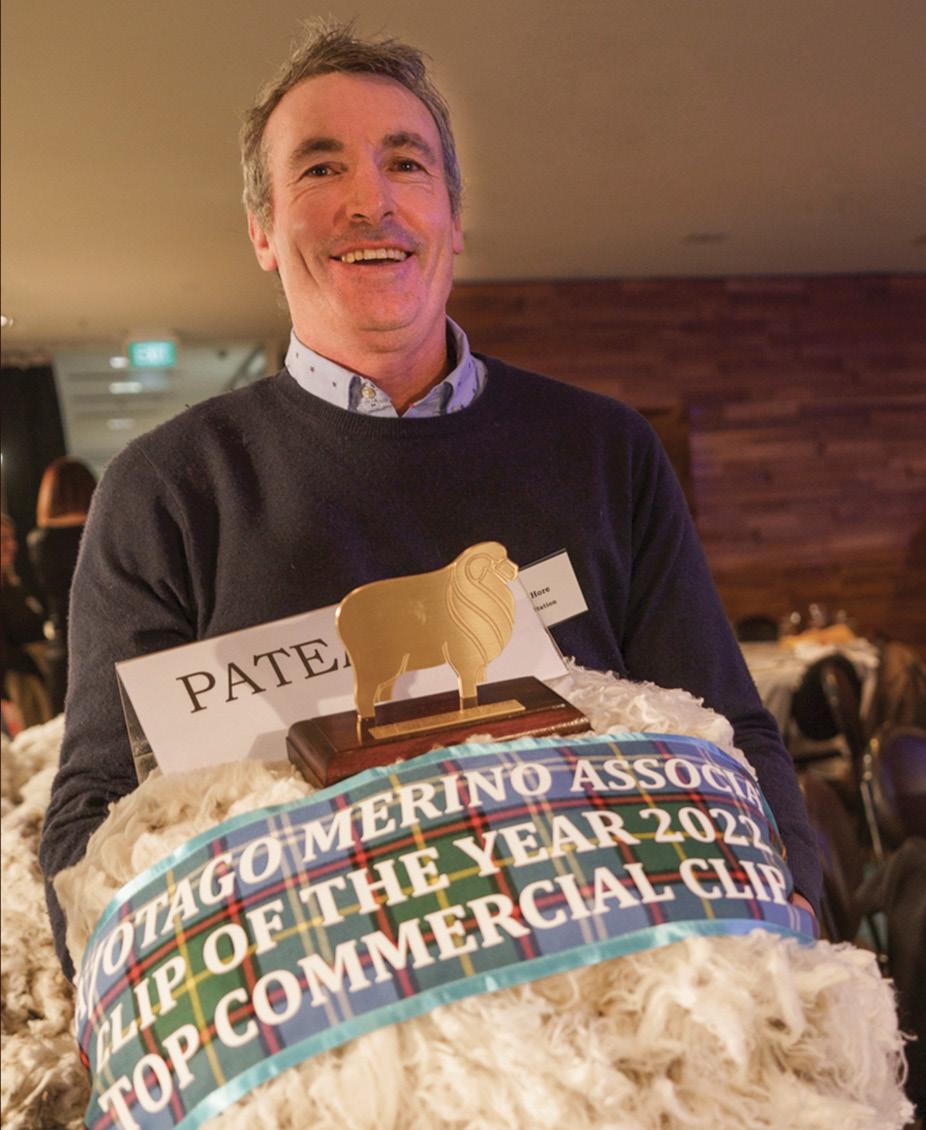
Peoples Choice Winner on Social Media "Ramp to Nowhere" by Eric Scott at Rees Valley Station.
Finalists: Sally Smith, Awapiri Station,
Awatere Valley, Samantha Harmer, Castle Ridge Station, Mid Canterbury, Leora Werner, Braeside Station, Oturehua. Voting on the above five by everyone at the Merino Awards evening resulted in;

1st: Leora Werner
2nd: Samantha Harmer
3rd: Sally Smith
Sectional Category - Up to 17 micron
1st: Patearoa, Charlie and Belinda Hore 2nd: Waikeri Downs, Earl and Bernadine Attfield
3rd: Matarae, Will and Emily Jones
Sectional Category - Over 17 micron
1st: Armidale, Simon and Sarah Paterson
2nd: Benmore, Andrew & Deidre, Bill & Kate Sutherland
3rd: Buscot, Richard and Jemma Gloag
Stud Flock
Winner: Armidale, Simon and Sarah Paterson
Commercial Flock
Winner: Patearoa, Charlie and Belinda Hore
Overall Winner COTY 2022
Winner: Armidale, Simon and Sarah Paterson
Balmoral
Benmore
Blairich
Cleardale
Earnscleugh Duncan Campbell Alexandra 027 659 6713
Glenlee Rob Hamilton Awatere Valley 03 575 7465
Glenmore Will and Emily Murray Lake Tekapo 03 680 6752
Glentanner Mark Ivey Mt Cook 03 426 9638
Grays Hills Mark and Sherie Urquhart Lake Tekapo 03 680 6640
Hawksburn Phillip McElroy Cromwell 03 445 0874
Isolation Rob and Sally Peter Ward 03 575 6866
Kaiwara Geoff Millar Swannanoa 03 312 6635
Lauder Grant and Robyn Calder Omakau 03 447 3377
Little Valley Lindon and Jenni Sanders Alexandra 03 448 6575
Malvern Downs Robbie Gibson Tarras 03 445 2839
Maryburn
Matangi
Matarae
William and Emily Jones Outram 03 464 3855
Middlehurst Willie Macdonald Wairau Valley 03 575 7042
Mount Hay John Simpson Fairlie 03 680 6897
Moutere Jopp Family Alexandra 03 447 3726
Muller Mike and Mary Satterthwaite Awatere Valley 03 575 7044
Nine Mile Gordon Lucas Tarras 03 445 2885
Otematata Hugh Cameron Otematata 03 438 7863
Sandown Helen Heddel Darfield 03 312 0404
Sawdon Robert Allan Lake Tekapo 03 680 6574
Somerton Park Isobel Somerton-Smythe Swannanoa 03 342 8488
Stonehenge Andrew Hore Ranfurly 03 444 7066
Strathclyde John McArthur Clyde 03 448 8335
The Gums Ian and Mark Stevenson Rangiora 03 319 8587
Upcot Bill Stevenson Awatere Valley 03 575 7463
Wairua Russell Smilie Hakataramea Valley 03 436 0287

